Microsoft RM-573 GSM/WCDMA Cellular Telephone w/ BT User Manual Manual
Microsoft Mobile Oy GSM/WCDMA Cellular Telephone w/ BT Manual
Manual

Nokia XXXX User Guide
xxxxxxx
Issue 1
Cyan
Cyan
Magenta
Magenta
Yellow
Yellow
Black
Black
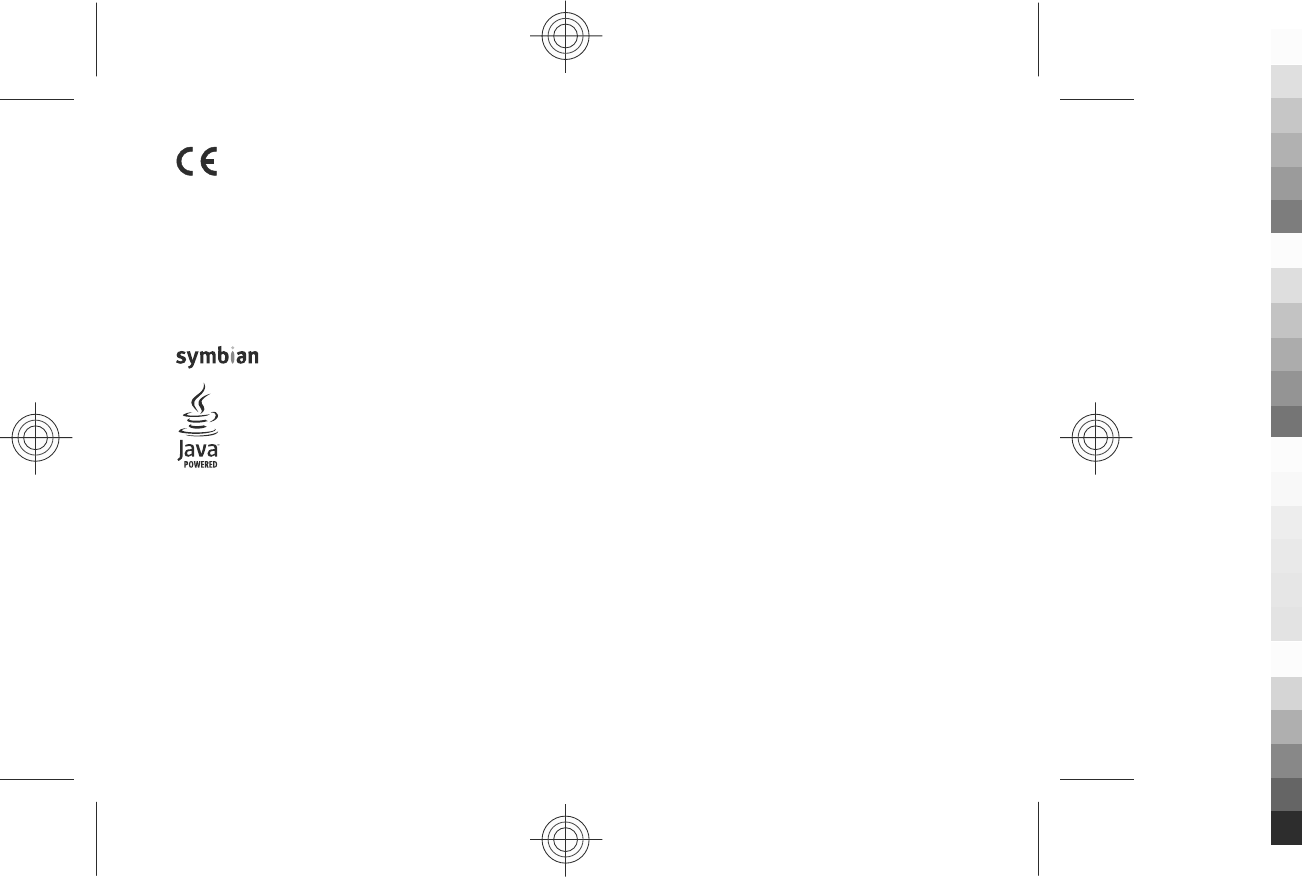
DECLARATION OF CONFORMITY
Hereby, NOKIA CORPORATION declares that this RM-573 product is in compliance with the essential requirements and other relevant
provisions of Directive 1999/5/EC. A copy of the Declaration of Conformity can be found at www.nokia.com/phones/
declaration_of_conformity/.
Nokia, Nokia Connecting People, Mail for Exchange, Navi, Ovi, and Nokia Original Enhancements logo are trademarks or registered trademarks of Nokia
Corporation. Nokia tune is a sound mark of Nokia Corporation. Other product and company names mentioned herein may be trademarks or tradenames of their
respective owners.
Reproduction, transfer, distribution, or storage of part or all of the contents in this document in any form without the prior written permission of Nokia is
prohibited. Nokia operates a policy of continuous development. Nokia reserves the right to make changes and improvements to any of the products described
in this document without prior notice.
This software is based in part of the work of the FreeType Team. This product is covered by one or more of the following patents: United States Patent 5,155,805,
United States Patent 5,325,479, United States Patent 5,159,668, United States Patent 2232861 and France Patent 9005712.
This product includes software licensed from Symbian Software Ltd ©1998-2009. Symbian and Symbian OS are trademarks of Symbian Ltd.
Java and all Java-based marks are trademarks or registered trademarks of Sun Microsystems, Inc.
Portions of the Nokia Maps software are ©1996-2009 The FreeType Project. All rights reserved.
This product is licensed under the MPEG-4 Visual Patent Portfolio License (i) for personal and noncommercial use in connection with information which has
been encoded in compliance with the MPEG-4 Visual Standard by a consumer engaged in a personal and noncommercial activity and (ii) for use in connection
with MPEG-4 video provided by a licensed video provider. No license is granted or shall be implied for any other use. Additional information, including that
related to promotional, internal, and commercial uses, may be obtained from MPEG LA, LLC. See http://www.mpegla.com.
TO THE MAXIMUM EXTENT PERMITTED BY APPLICABLE LAW, UNDER NO CIRCUMSTANCES SHALL NOKIA OR ANY OF ITS LICENSORS BE RESPONSIBLE FOR ANY LOSS OF
DATA OR INCOME OR ANY SPECIAL, INCIDENTAL, CONSEQUENTIAL OR INDIRECT DAMAGES HOWSOEVER CAUSED.
THE CONTENTS OF THIS DOCUMENT ARE PROVIDED "AS IS". EXCEPT AS REQUIRED BY APPLICABLE LAW, NO WARRANTIES OF ANY KIND, EITHER EXPRESS OR IMPLIED,
INCLUDING, BUT NOT LIMITED TO, THE IMPLIED WARRANTIES OF MERCHANTABILITY AND FITNESS FOR A PARTICULAR PURPOSE, ARE MADE IN RELATION TO THE ACCURACY,
RELIABILITY OR CONTENTS OF THIS DOCUMENT. NOKIA RESERVES THE RIGHT TO REVISE THIS DOCUMENT OR WITHDRAW IT AT ANY TIME WITHOUT PRIOR NOTICE.
Reverse engineering of software in the device is prohibited to the extent permitted by applicable law. Insofar as this user guide contains any limitations on
Nokia's representations, warranties, damages and liabilities, such limitations shall likewise limit any representations, warranties, damages and liabilities of
Nokia's licensors.
0434
Cyan
Cyan
Magenta
Magenta
Yellow
Yellow
Black
Black

The availability of particular products and applications and services for these products may vary by region. Please check with your Nokia dealer for details and
availability of language options. This device may contain commodities, technology or software subject to export laws and regulations from the US and other
countries. Diversion contrary to law is prohibited.
FCC/INDUSTRY CANADA NOTICE
Your device may cause TV or radio interference (for example, when using a telephone in close proximity to receiving equipment). The FCC or Industry Canada
can require you to stop using your telephone if such interference cannot be eliminated. If you require assistance, contact your local service facility. This device
complies with part 15 of the FCC rules. Operation is subject to the following two conditions: (1) This device may not cause harmful interference, and (2) this
device must accept any interference received, including interference that may cause undesired operation. Any changes or modifications not expressly approved
by Nokia could void the user's authority to operate this equipment.
xxxxxxx/Issue 1 EN
Cyan
Cyan
Magenta
Magenta
Yellow
Yellow
Black
Black

Contents
Safety................................................................7
About your device.................................................................7
Office applications................................................................8
Network services...................................................................8
Shared memory.....................................................................8
Support.............................................................9
1. Frequently asked questions.......................10
What is the lock code?.......................................................10
Where can I get settings for my device?..........................10
How can I transfer content from my old device?............10
2. Get started..................................................11
Keys and parts.....................................................................11
Insert the SIM card and battery.........................................12
Charge the battery..............................................................13
Switch the device on or off................................................14
Lock the keys.......................................................................14
Connect the headset...........................................................14
Memory cards......................................................................15
Shortcuts..............................................................................16
3. Your Nokia XXXX.........................................18
Phone setup........................................................................18
Settings wizard...................................................................18
Transfer content.................................................................18
Make calls............................................................................19
Voice mail ...........................................................................19
Volume control....................................................................20
Write text with the keyboard............................................20
Write and send messages..................................................21
Active standby.....................................................................22
Menu....................................................................................22
Indicators.............................................................................22
Clock.....................................................................................23
Antenna locations...............................................................24
4. Personalise your device..............................25
Profiles ................................................................................25
Select ringing tones............................................................25
Change the display theme.................................................25
5. E-mail and instant messaging....................27
Messaging key.....................................................................27
Ovi Mail................................................................................27
Mail for Exchange................................................................27
Chat......................................................................................27
6. Nokia Maps.................................................29
Positioning (GPS)................................................................29
About Maps..........................................................................30
Move on a map....................................................................31
Plan a route.........................................................................31
Navigate to the destination..............................................32
7. Internet and connectivity...........................33
Internet key.........................................................................33
Browser................................................................................33
Fast downloading...............................................................35
Contents
Cyan
Cyan
Magenta
Magenta
Yellow
Yellow
Black
Black

Connect the USB data cable...............................................35
Bluetooth.............................................................................36
Connection manager..........................................................38
8. Calendar and contacts................................39
Create a calendar entry......................................................39
Calendar views....................................................................39
Save and edit names and numbers..................................39
Create contact groups........................................................40
Add ringing tones for contacts..........................................40
9. Images and music......................................41
Camera.................................................................................41
Gallery..................................................................................41
About Ovi Share..................................................................42
Music player.........................................................................42
FM radio...............................................................................43
RealPlayer............................................................................44
10. Office applications....................................45
Calculator.............................................................................45
Convert measurements......................................................45
Find and organise files.......................................................45
Quickoffice...........................................................................46
Zip manager........................................................................46
PDF reader...........................................................................46
11. Downloads................................................47
Application manager..........................................................47
Download!...........................................................................48
12. Protect your device and data...................50
Lock the device...................................................................50
Memory card security.........................................................50
Back up data........................................................................51
Be careful when you connect............................................51
13. Settings.....................................................52
General settings..................................................................52
Phone settings....................................................................52
Connection settings............................................................52
Application settings............................................................53
14. Green tips.................................................54
Save energy.........................................................................54
Recycle.................................................................................54
Save paper...........................................................................54
Learn more..........................................................................54
Accessories.....................................................55
Battery............................................................56
Battery and charger information......................................56
Nokia battery authentication guidelines.........................57
Taking care of your device.............................58
Recycle.................................................................................58
Additional safety information.......................60
Small children.....................................................................60
Operating environment.....................................................60
Medical devices...................................................................60
Vehicles................................................................................61
Potentially explosive environments.................................61
Contents
Cyan
Cyan
Magenta
Magenta
Yellow
Yellow
Black
Black
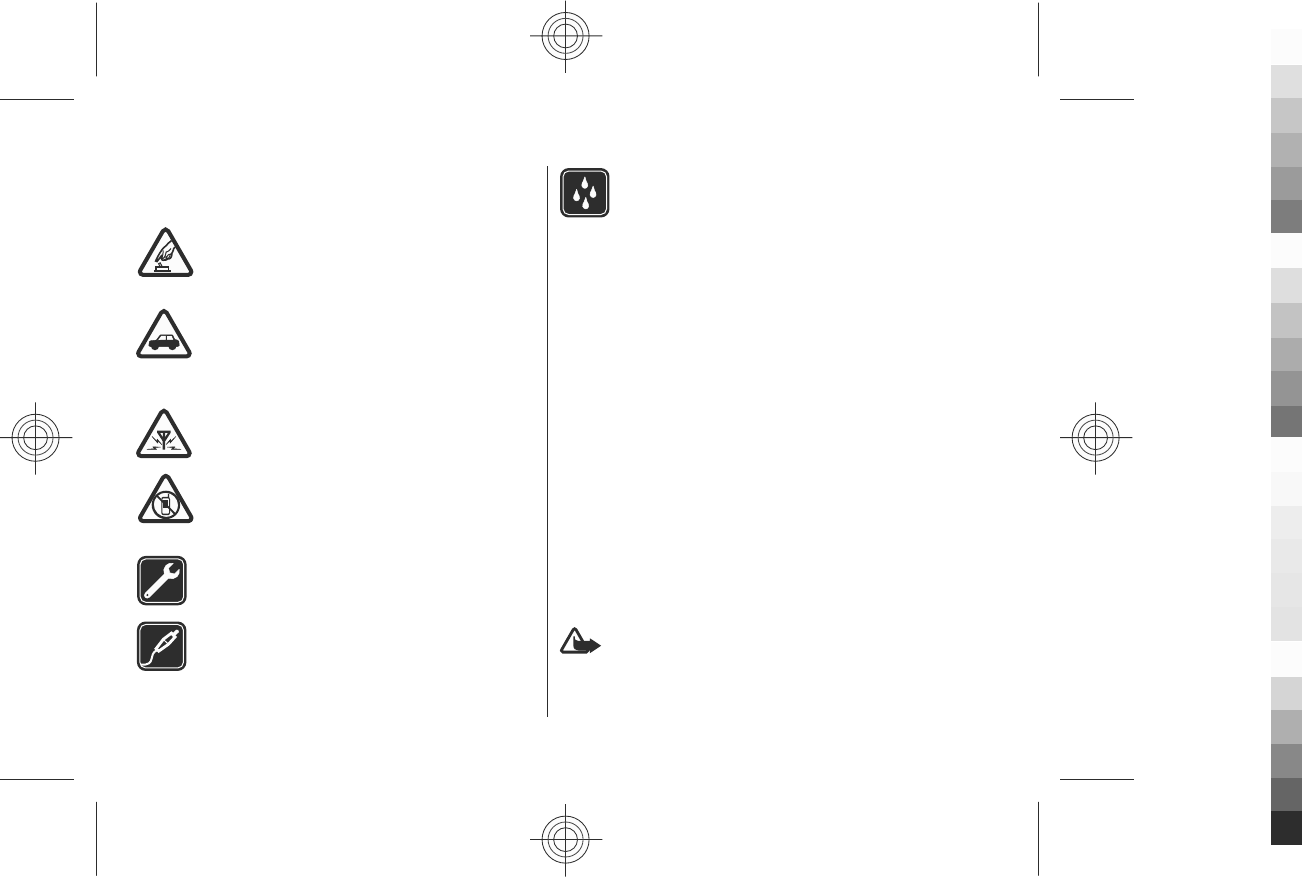
Safety
Read these simple guidelines. Not following them may be
dangerous or illegal. Read the complete user guide for
further information.
SWITCH ON SAFELY
Do not switch the device on when wireless
phone use is prohibited or when it may cause
interference or danger.
ROAD SAFETY COMES FIRST
Obey all local laws. Always keep your hands free
to operate the vehicle while driving. Your first
consideration while driving should be road
safety.
INTERFERENCE
All wireless devices may be susceptible to
interference, which could affect performance.
SWITCH OFF IN RESTRICTED AREAS
Follow any restrictions. Switch the device off in
aircraft, near medical equipment, fuel,
chemicals, or blasting areas.
QUALIFIED SERVICE
Only qualified personnel may install or repair
this product.
ACCESSORIES AND BATTERIES
Use only approved accessories and batteries. Do
not connect incompatible products.
WATER-RESISTANCE
Your device is not water-resistant. Keep it dry.
About your device
The wireless device described in this guide is approved for
use on the (E)GSM 850/900/1800/1900 and UMTS
900/2100 HSDPA networks. Contact your service provider
for more information about networks.
Your device supports several connectivity methods and
like computers may be exposed to viruses and other
harmful content. Exercise caution with messages,
connectivity requests, browsing, and downloads. Only
install and use services and software from trustworthy
sources that offer adequate security and protection, such
as applications that are Symbian Signed or have passed
the Java Verified™ testing. Consider installing antivirus
and other security software on your device and any
connected computer.
Your device may have preinstalled bookmarks and links for
third-party internet sites and may allow you to access
third-party sites. These are not affiliated with Nokia, and
Nokia does not endorse or assume liability for them. If you
access such sites, take precautions for security or content.
Warning: To use any features in this device, other
than the alarm clock, the device must be switched on. Do
not switch the device on when wireless device use may
cause interference or danger.
7
Safety
Cyan
Cyan
Magenta
Magenta
Yellow
Yellow
Black
Black

When using this device, obey all laws and respect local
customs, privacy and legitimate rights of others, including
copyrights. Copyright protection may prevent some
images, music, and other content from being copied,
modified, or transferred.
Make back-up copies or keep a written record of all
important information stored in your device.
When connecting to any other device, read its user guide
for detailed safety instructions. Do not connect
incompatible products.
The images in this guide may differ from your device
display.
Refer to the user guide for other important information
about your device.
Office applications
The office applications support common features of
Microsoft Word, PowerPoint, and Excel (Microsoft Office
2000, XP, and 2003). Not all file formats are supported.
Network services
To use the device you must have service from a wireless
service provider. Some features are not available on all
networks; other features may require that you make
specific arrangements with your service provider to use
them. Network services involve transmission of data.
Check with your service provider for details about fees in
your home network and when roaming on other
networks. Your service provider can explain what charges
will apply. Some networks may have limitations that affect
how you can use some features of this device requiring
network support such as support for specific technologies
like WAP 2.0 protocols (HTTP and SSL) that run on TCP/IP
protocols and language-dependent characters.
Your service provider may have requested that certain
features be disabled or not activated in your device. If so,
these features will not appear on your device menu. Your
device may also have customized items such as menu
names, menu order, and icons.
Shared memory
The following features in this device may share memory:
tones, graphics, contacts, text messages, multimedia
messages, instant messages, e-mail, calendar, games,
notes, and applications. Use of one or more of these
features may reduce the memory available for the
remaining features. If your device displays a message that
the memory is full, delete some of the information stored
in the shared memory.
8
Safety
Cyan
Cyan
Magenta
Magenta
Yellow
Yellow
Black
Black

Support
When you want to learn more about how to use your product or you are unsure how your device should function, see
the support pages at www.nokia.com/support or your local Nokia website, www.nokia.mobi/support (with a mobile
device), the Help application in the device, or the user guide.
If this does not resolve your issue, do the following:
●Restart the device: switch off the device, and remove the battery. After about a minute, replace the battery, and
switch on the device.
●With the Nokia Software Updater application, update your device software regularly for optimum performance and
possible new features. See www.nokia.com/softwareupdate or your local Nokia website. Remember to back up your
device data before updating the device software.
●Restore the original factory settings as explained in the user guide. Your documents and files are not deleted in the
reset.
If the issue remains unsolved, contact Nokia for repair options. See www.nokia.com/repair. Before sending your device
for repair, always back up the data in your device.
9
Support
Cyan
Cyan
Magenta
Magenta
Yellow
Yellow
Black
Black

1. Frequently asked questions
When you take a new device into use, you may have
questions. In addition to those answered in this guide,
visit the product support pages of the Nokia website.
What is the lock code?
Your device is equipped with one or more codes to protect
the device itself or the SIM card against unauthorised use.
Lock code
The lock code (also known as security code) protects your
device against unauthorised use. The preset code is 12345.
You can change the code, and set the device to request the
code. See "Lock the device", p. 50.
You must remember the new code, and keep it secret and
in a safe place separate from your device. If you forget the
lock code and your device is locked, you must take the
device to a Nokia authorised service facility and additional
charges may apply. To unlock the device, the software
must be reloaded, and the data you have saved in the
device may be lost.
PIN and PUK codes
If you forget any of the following access codes, contact
your service provider.
●Personal identification number (PIN) code — This code
protects your SIM card against unauthorised use. The
PIN code (4-8 digits) is usually supplied with the SIM
card. After three consecutive incorrect PIN code entries,
the code is blocked, and you need the PUK code to
unblock it.
●PIN2 code — This code (4-8 digits) is supplied with
some SIM cards, and is required to access some
functions in your device.
●Personal Unblocking Key (PUK) code and PUK2
code — These codes (8 digits) are required to change a
blocked PIN code or PIN2 code, respectively. If the codes
are not supplied with the SIM card, contact the operator
whose SIM card is in your device.
Where can I get settings for my
device?
Your device normally has MMS, GPRS, streaming, and
mobile internet settings automatically configured, based
on your network service provider information. You may
have settings from your service providers already installed
in your device, or you may receive or request the settings
from the network service providers as a special message.
You can also use the Settings wizard application to define
the settings. See "Settings wizard", p. 18.
How can I transfer content from my
old device?
You can use the Nokia Switch application to copy content
such as phone numbers, addresses, calendar items, and
images from your previous Nokia device to your Nokia
XXXX. See "Transfer content", p. 18.
10
Frequently asked questions
Cyan
Cyan
Magenta
Magenta
Yellow
Yellow
Black
Black
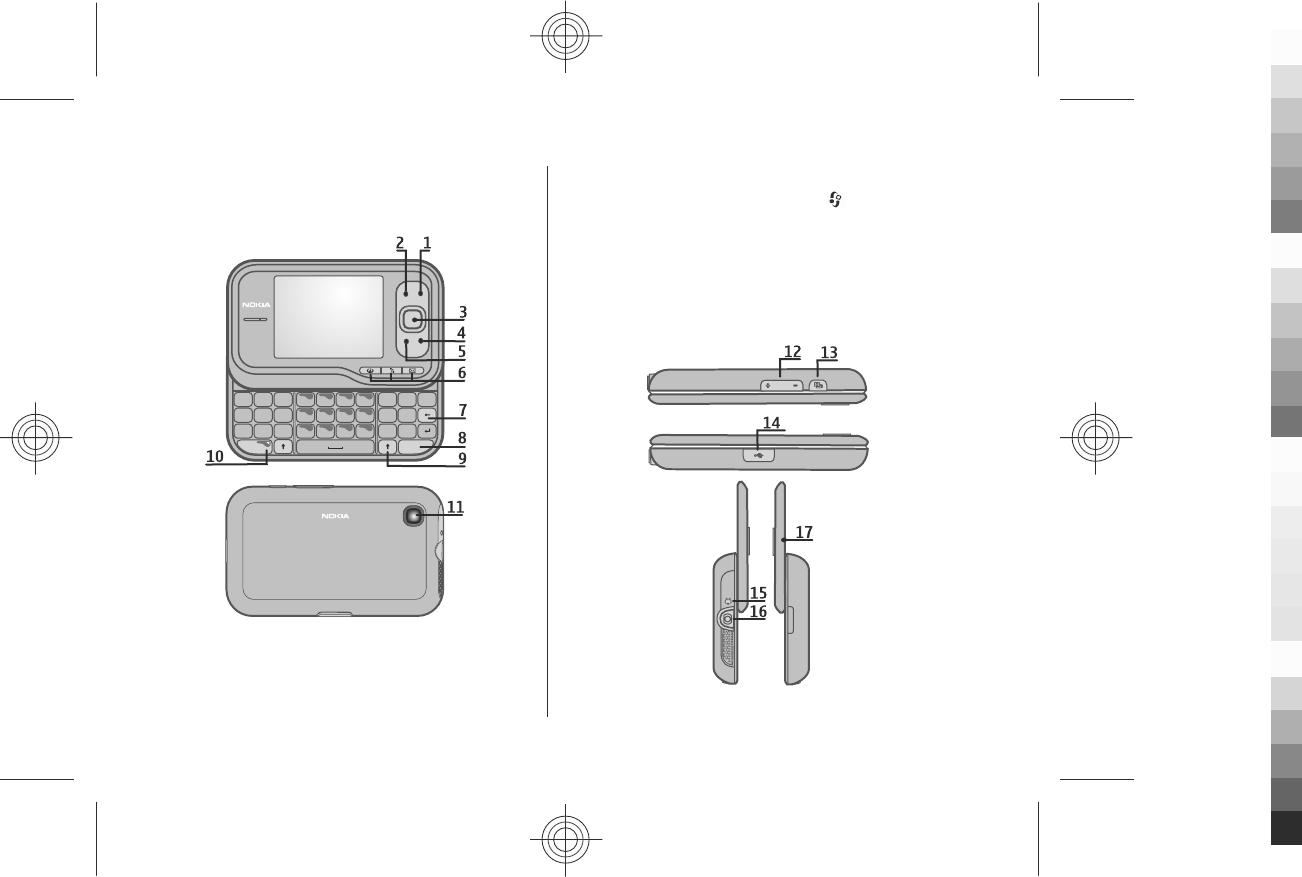
2. Get started
Model number: XXXX.
Keys and parts
1 — Power/End key
2 — Right selection key
3 — Navi™ key; hereafter referred as scroll key
4 — Call key
5 — Left selection key
6 — Quick access keys: internet, menu , and messaging
keys
7 — Backspace key
8 — Sym (symbol) key
9 — Shift key
10 — Function key
11 — Camera
12 — Volume keys 11
Get started
Cyan
Cyan
Magenta
Magenta
Yellow
Yellow
Black
Black
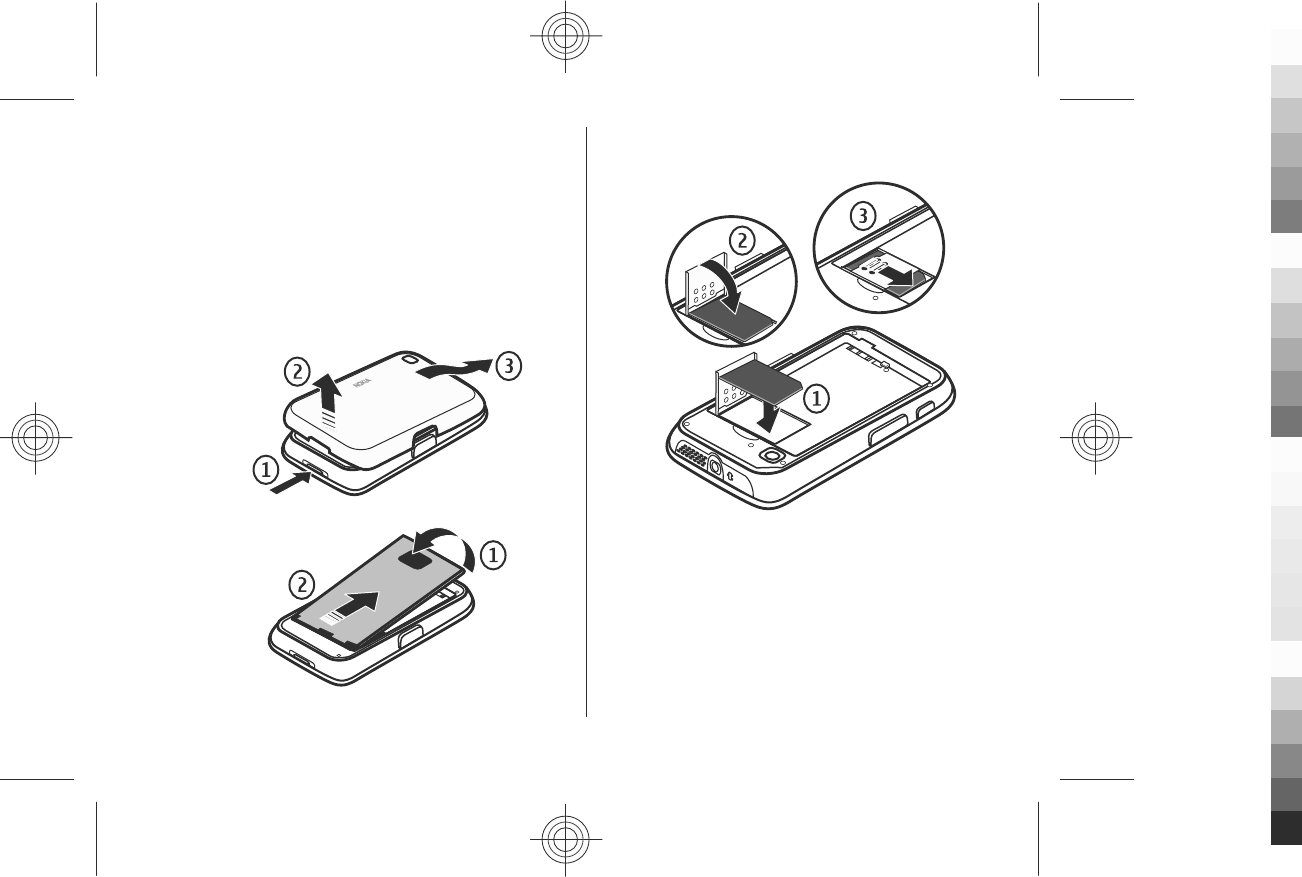
13 — Capture key
14 — Micro USB connector
15 — Charger connector
16 — Headset connector
17 — Microphone
Insert the SIM card and battery
Safe removal. Always switch the device off and disconnect
the charger before removing the battery.
1. Remove the back cover.
2. Remove the battery, if inserted.
3. Insert the SIM card in the card holder. Ensure that the
contact area on the card faces down. Close the SIM card
holder, and slide the cover of the holder to lock it.
4. Align the battery contacts with the battery
compartment connectors, and insert the battery.
12
Get started
Cyan
Cyan
Magenta
Magenta
Yellow
Yellow
Black
Black
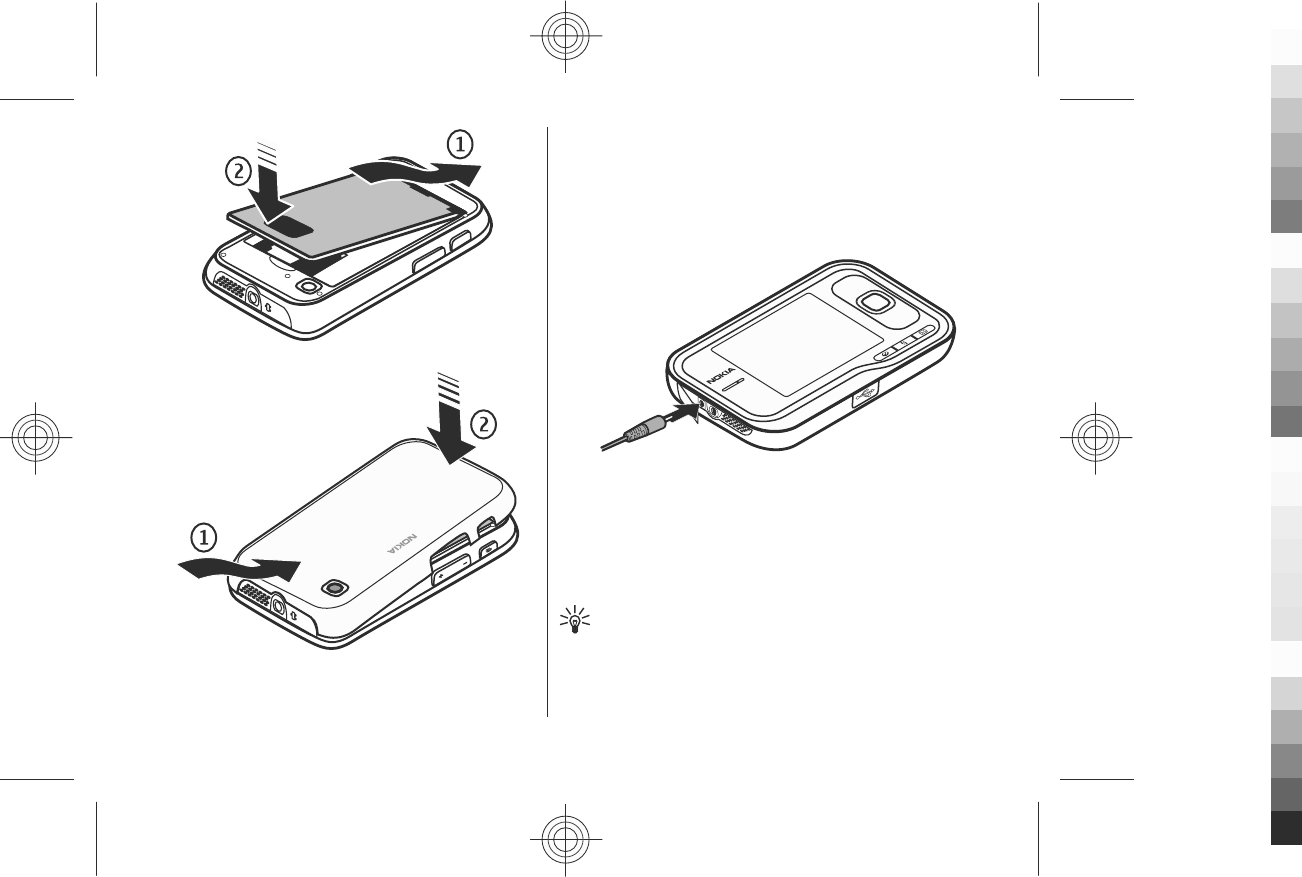
5. Replace the back cover.
Charge the battery
Your battery has been partially charged at the factory. If
the device indicates a low charge, do the following:
1. Connect the charger to a wall outlet.
2. Connect the charger to the device. The charging port is
behind the black cover.
3. When the device indicates a full charge, disconnect the
charger from the device, then from the wall outlet.
You do not need to charge the battery for a specific length
of time, and you can use the device while it is charging. If
the battery is completely discharged, it may take several
minutes before the charging indicator appears on the
display or before any calls can be made.
Tip: Disconnect the charger from the wall outlet
when the charger is not in use. A charger that is
connected to the outlet consumes power even
when it is not connected to the device.
13
Get started
Cyan
Cyan
Magenta
Magenta
Yellow
Yellow
Black
Black
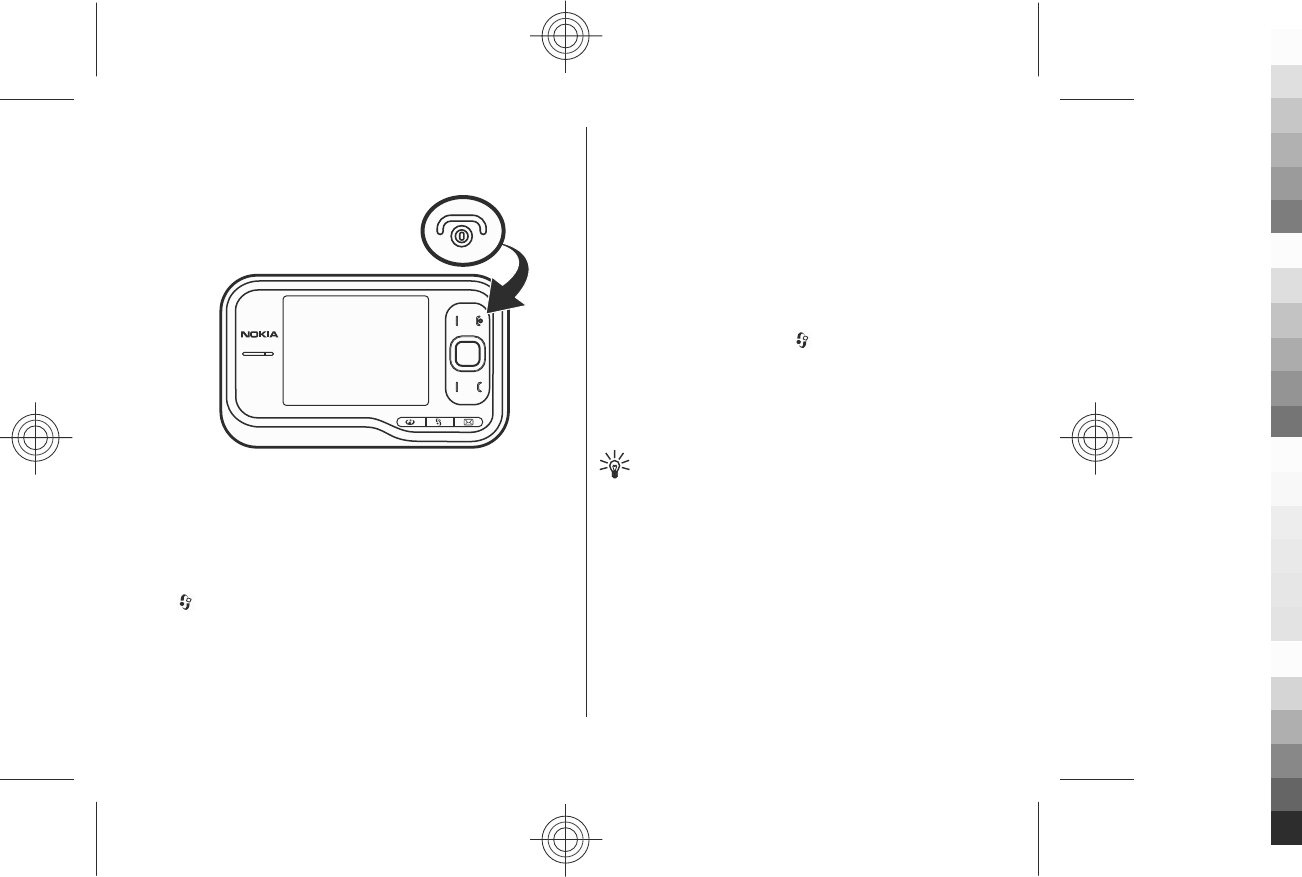
Switch the device on or off
Press and hold the power key until you feel the device
vibrate.
If prompted, enter the PIN code or lock code, and select
OK. If the device asks for the lock code, enter the lock code,
and select OK. See "What is the lock code?", p. 10.
The Phone setup application opens when you switch on
your device for the first time. With the Phone setup
application, you can customise how the device looks and
works. To open the Phone setup application later, select
> Applications > Help > Phone setup.
To set the correct time zone, time, and date, select the
country you are located and the current date and time. To
find your country, enter the first letters of the country
name. It is important to select the correct country, because
scheduled calendar entries may change if you change the
country later and the new country is located in a different
time zone.
Lock the keys
When the device or keypad is locked, calls may be possible
to the official emergency number programmed into your
device.
You can set the keypad to lock automatically after a time-
out period, or when the slide is closed.
To change the length of the time-out period, after which
the keypad is locked, select > Tools > Settings and
General > Security > Phone and SIM card > Keypad
autolock period > User defined and the desired length
of time.
To manually lock the keypad in phone mode, press the end
key, and select Lock keypad.
Tip: When the keypad is locked, press and hold the
scroll key to quickly view the date and time.
Connect the headset
Connect the compatible headset to the headset connector
of your device.
14
Get started
Cyan
Cyan
Magenta
Magenta
Yellow
Yellow
Black
Black
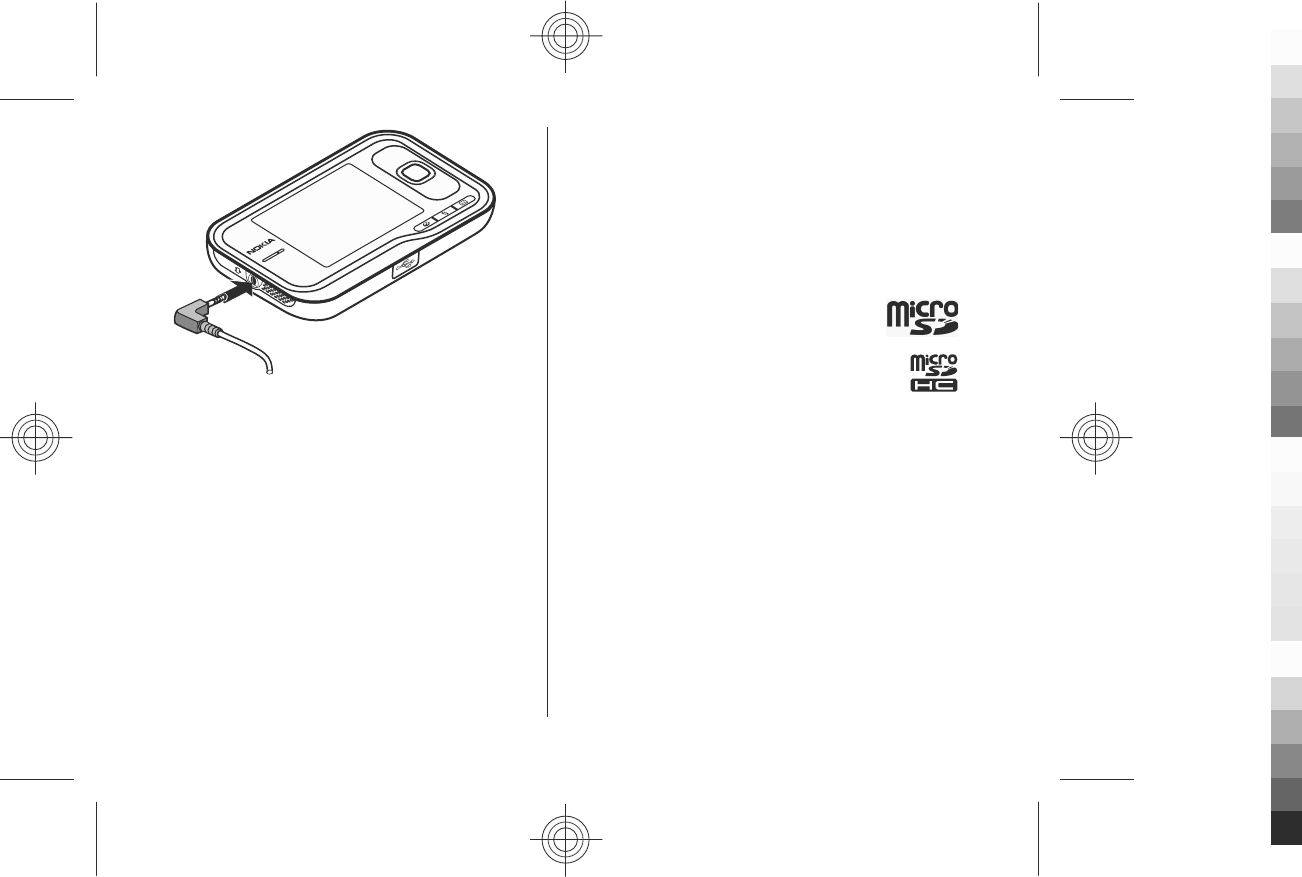
Do not connect products that create an output signal as
this may cause damage to the device. Do not connect any
voltage source to the Nokia AV Connector.
When connecting any external device or any headset,
other than those approved by Nokia for use with this
device, to the Nokia AV Connector, pay special attention to
volume levels.
Memory cards
Supported memory cards
Use only compatible microSD cards approved by Nokia for
use with this device. Nokia uses approved industry
standards for memory cards, but some brands may not be
fully compatible with this device. Incompatible cards may
damage the card and the device and corrupt data stored
on the card.
Keep all memory cards out of the reach of small children.
You can extend the available memory with a microSDHC or
microSD card with a capacity of up to 8 GB. Optimal
performance is with a 4 GB microSD card. You can insert or
remove a microSDHC or microSD card without switching
the device off.
To maximize the performance of your device, it is
recommended that no more than 100 files are stored in
any folder.
Insert the memory card
Use a memory card to increase the amount of memory
available for your device. You can also back up information
from your device to the memory card.
Check the compatibility of a memory card with its
manufacturer or provider.
A compatible memory card may be included in the sales
package. The memory card may be already inserted in the
device. If not, do the following:
1. Remove the back cover.
2. Insert the memory card in the slot with the contact
area first. Ensure the contact area is facing the
connectors on the device.
15
Get started
Cyan
Cyan
Magenta
Magenta
Yellow
Yellow
Black
Black
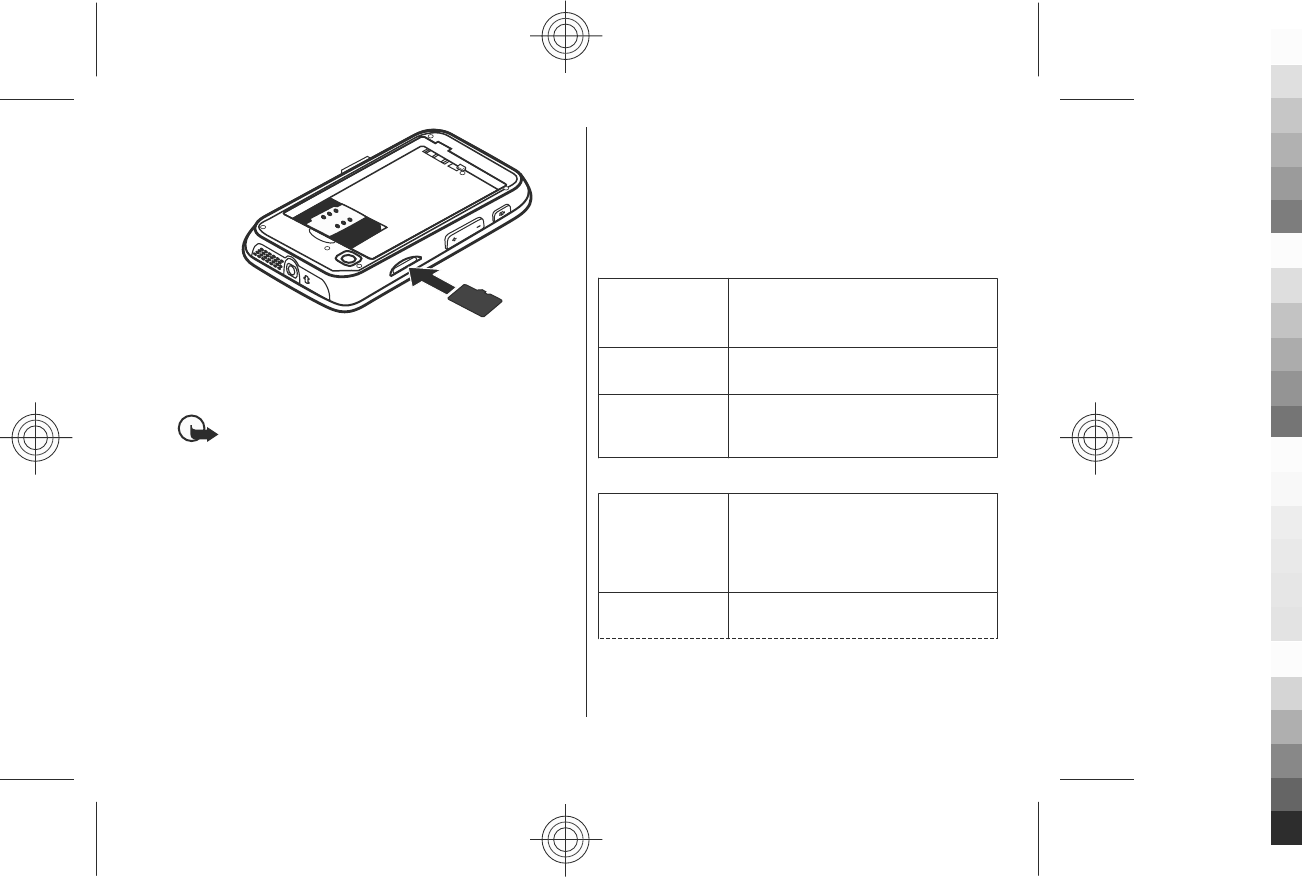
3. Push the card in until it locks into place.
4. Close the back cover.
Remove the memory card
Important: Do not remove the memory card
during an operation when the card is being accessed.
Doing so may damage the memory card and the device,
and corrupt data stored on the card.
1. Press the power key briefly, and select Remove
memory card.
2. Remove the back cover.
3. Press the end of the memory card to release it from the
memory card slot, and remove the card.
4. Replace the cover.
Shortcuts
Here are some of the keyboard shortcuts in your device.
Shortcuts can make the use of the applications more
efficient.
Shortcuts
General shortcuts
Power key Press and hold to switch your device
on and off.
Press once to switch between profiles.
#Press and hold # to activate the Silent
profile.
Scroll key Press and hold the scroll key to view
the screen saver clock when the
keypad is locked.
Standby mode
Call key Open the call log. Up to 20 numbers
that you last called or attempted to
call are displayed. Scroll to the desired
number or name, and press the call
key.
0Press and hold to open your
homepage in the browser.
16
Get started
Cyan
Cyan
Magenta
Magenta
Yellow
Yellow
Black
Black
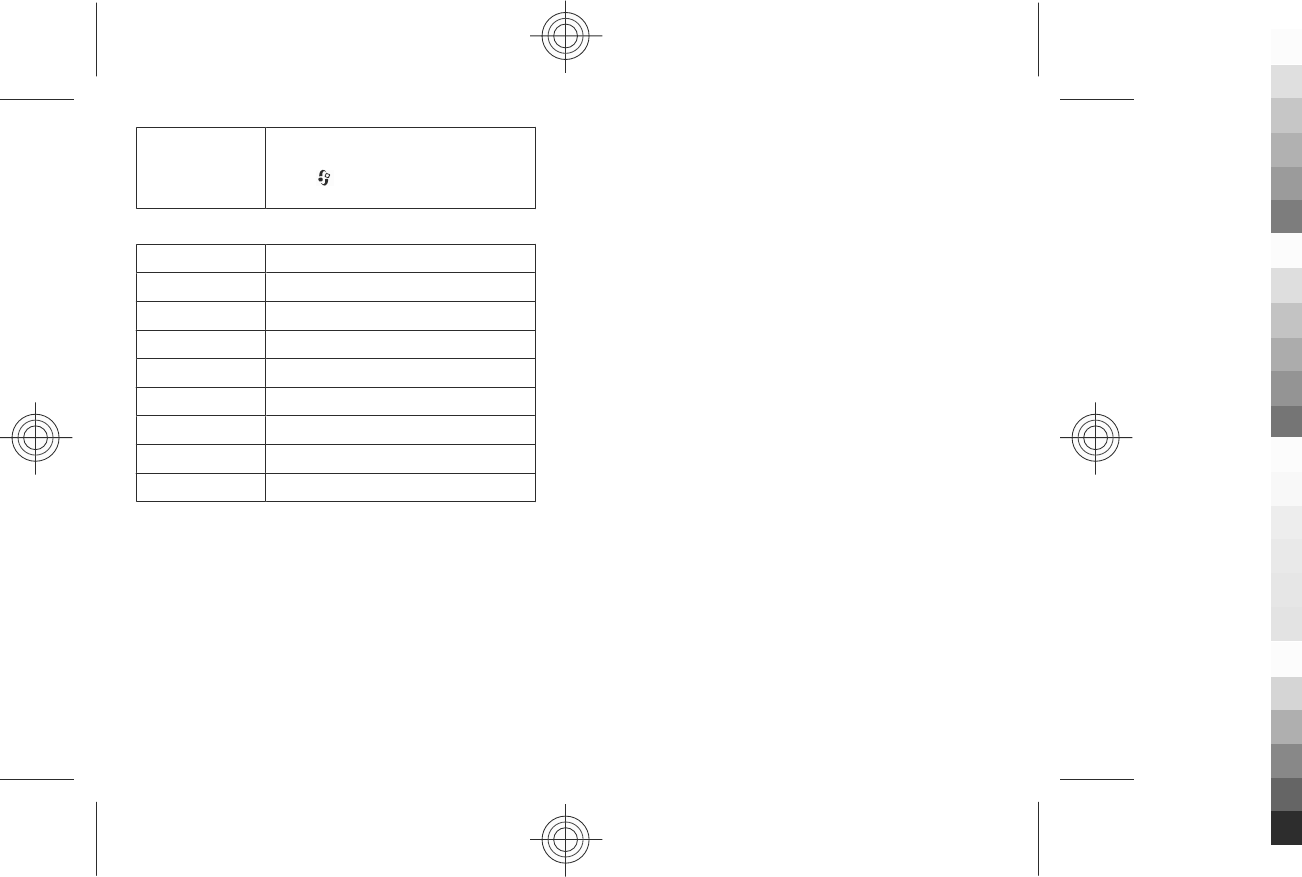
Number key (2–
9)
Call a phone number using speed
dialling. To activate speed dialling,
select > Tools > Settings and
Phone > Call > Speed dialling.
Web shortcuts
Function key + * Zoom in the page.
Function key + # Zoom out the page.
yGo to the homepage.
rOpen the bookmarks folder.
tOpen the search dialog.
pReturn to the previous page.
wView the active pages.
bView the page overview.
nEnter a new web address.
17
Get started
Cyan
Cyan
Magenta
Magenta
Yellow
Yellow
Black
Black

3. Your Nokia XXXX
After you have switched on your device, start to explore.
Phone setup
When you switch on your device for the first time, the
Phone setup application opens.
To access the Phone setup application later, select >
Applications > Help > Phone setup.
To set up the device connections, select Settings
wizard.
To transfer data to your device from a compatible Nokia
device, select Phone switch.
The available options may vary.
Settings wizard
Select > Tools > Sett. wizard.
Use Settings wizard to define e-mail and connection
settings. The availability of the items in Settings wizard
depends on the features of the device, SIM card, service
provider, and the data in the Settings wizard database.
To start Settings wizard, select Start.
To get the best results when using the settings wizard,
keep your SIM card inserted in the device. If the SIM card
is not inserted, follow the instructions on the display.
Select from the following:
●Operator — Define the operator-specific settings, such
as MMS, internet, WAP, and streaming settings.
●E-mail setup — Configure a POP, IMAP, or Mail for
Exchange account.
●Video sharing — Configure video sharing settings.
The settings available for editing may vary.
Transfer content
The type of content that can be transferred depends on
the model of the device from which you want to transfer
content. If that device supports synchronisation, you can
also synchronise data between the devices. Your Nokia
XXXX notifies you if the other device is not
compatible.
If the other device cannot be switched on without a SIM
card, you can insert your SIM card in it. When your Nokia
XXXX is switched on without a SIM card, the offline
profile is automatically activated, and transfer can be
done.
Transfer content for the first time
1. To retrieve data from the other device for the first time,
on your Nokia XXXX, select Switch in the Phone
setup application, or select > Tools > Switch.
2. Select the connection type you want to use to transfer
the data. Both devices must support the selected
connection type.
3. If you select Bluetooth, connect the two devices. To
have your device search for devices with Bluetooth
18
Your Nokia XXXX
Cyan
Cyan
Magenta
Magenta
Yellow
Yellow
Black
Black
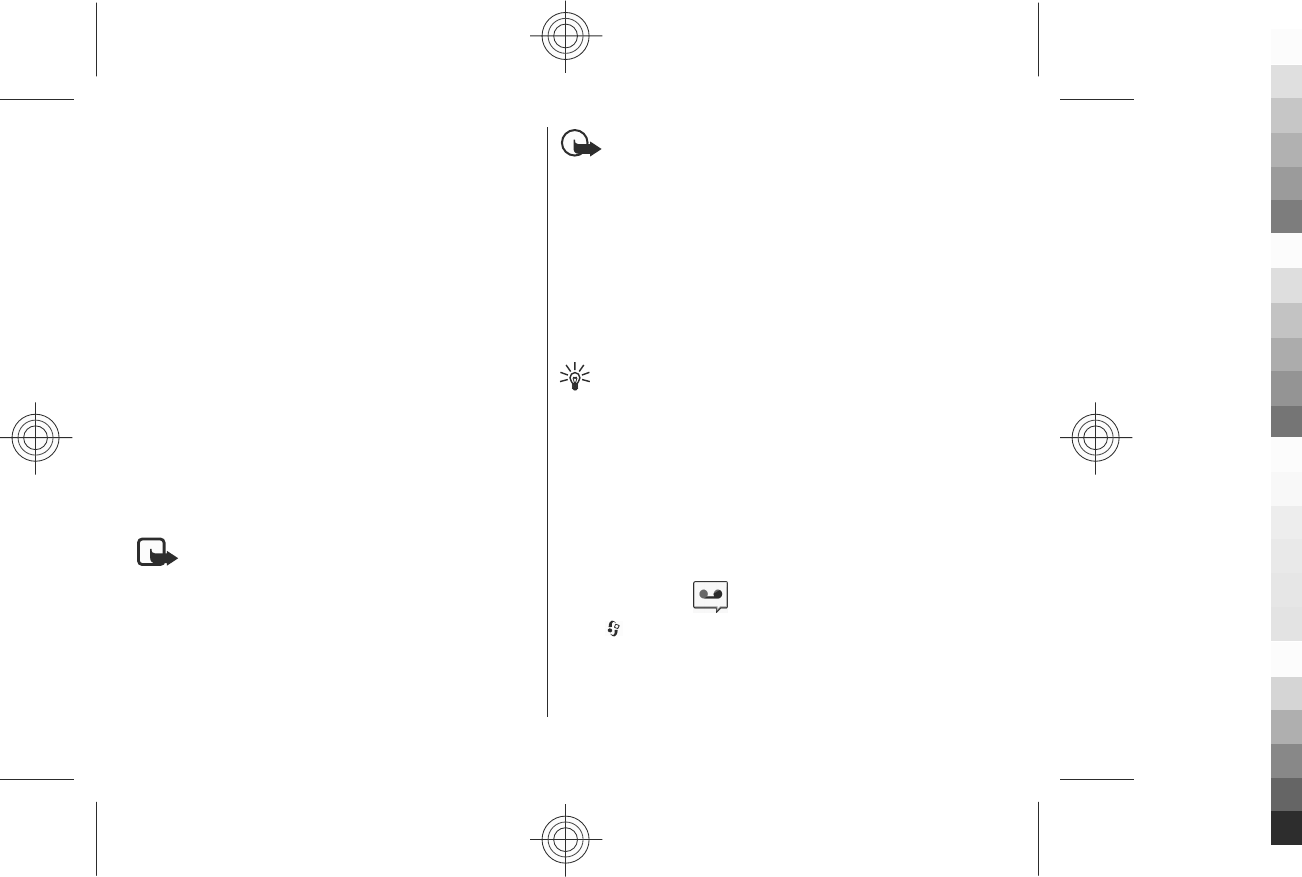
connectivity, select Continue. Select the device from
which you want to transfer content. You are asked to
enter a code on your Nokia XXXX. Enter a code
(1-16 digits), and select OK. Enter the same code on the
other device, and select OK. The devices are now
paired.
Some earlier Nokia devices may not have the Switch
application. In this case, the Switch application is sent
to the other device as a message. To install Switch on
the other device, open the message, and follow the
instructions.
4. From your Nokia XXXX, select the content you
want to transfer from the other device.
When the transfer has started, you can cancel it and
continue later.
Content is transferred from the memory of the other
device to the corresponding location in your Nokia XXXX.
The length of the transfer time depends on the
amount of data to be transferred.
Make calls
Note: The actual invoice for calls and services from
your service provider may vary, depending on network
features, rounding off for billing, taxes, and so forth.
To make and receive calls, the device must be switched on,
it must have a valid SIM card installed, and you must be
located in the service area of a cellular network.
Important: In the Offline profile you cannot make
or receive any calls, or use other features that require
cellular network coverage. Calls may still be possible to the
official emergency number programmed into your device.
To make calls, you must first activate the phone function
by changing profiles. If the device has been locked, enter
the lock code.
Make calls
To make a call, enter the phone number, including the area
code, and press the call key. To end the call or cancel the
call attempt, press the end key.
Tip: For international calls, add the + character that
replaces the international access code, and enter
the country code, area code (omit the leading 0, if
necessary), and phone number.
Answer a call
To answer a call, press the call key. To reject a call, press
the end key.
To mute the ringing tone instead of answering a call, select
Silence.
To adjust the volume of an active call, use the volume keys.
Voice mail
Select > Tools > Call mailbox.
When you open the Voice mail application for the first
time, you are asked to enter the number of your voice
mailbox.
19
Your Nokia XXXX
Cyan
Cyan
Magenta
Magenta
Yellow
Yellow
Black
Black
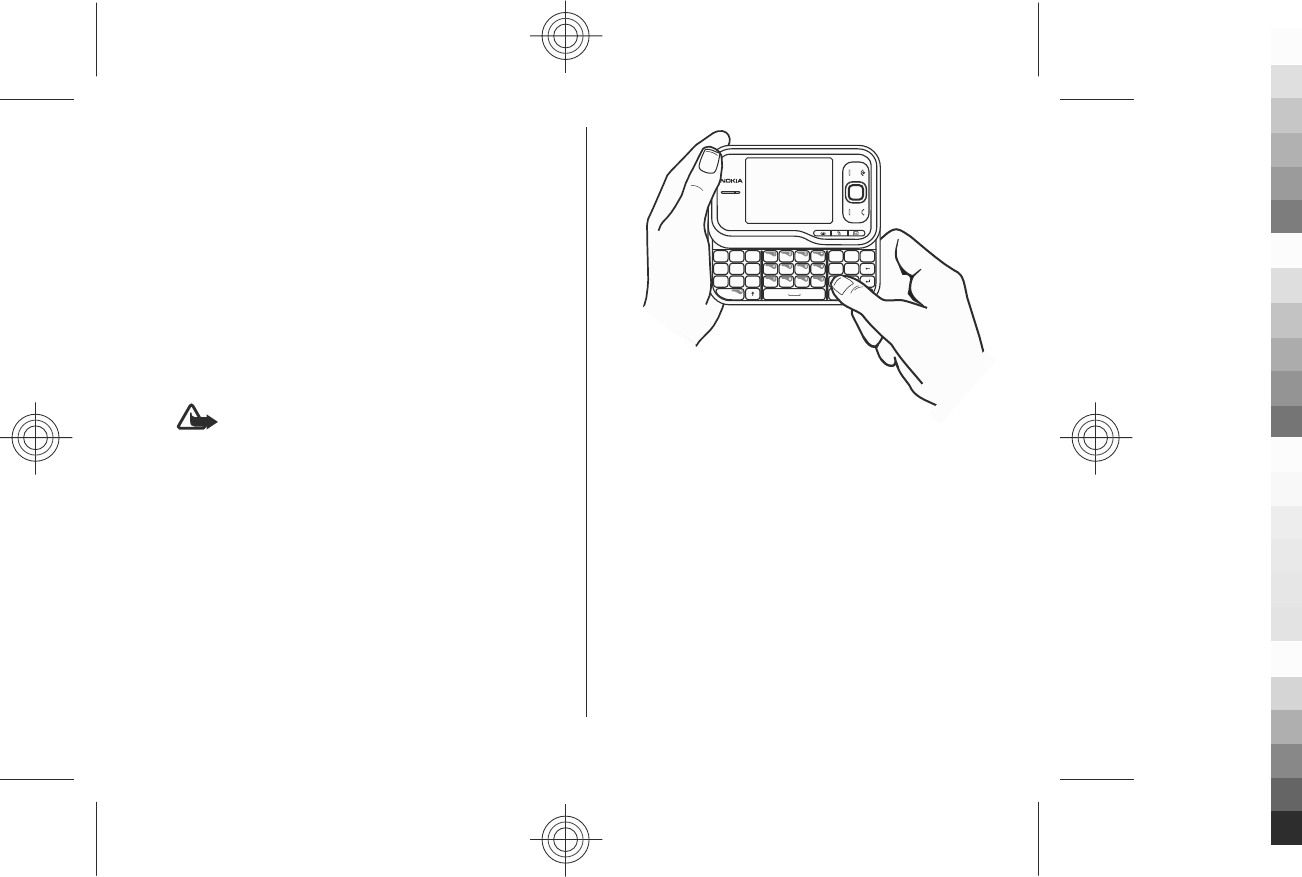
To call your voice mailbox, scroll to Voice mailbox, and
select Options > Call voice mailbox.
To call your mailbox in the standby mode, press and hold
1; or press 1 and then the call key. Select the mailbox you
want to call.
To change the mailbox number, select the mailbox and
Options > Change number.
Volume control
To adjust the earpiece or loudspeaker volume during a call
or when listening to an audio file, use the volume keys.
To activate or deactivate the loudspeaker during a call,
select Loudsp. or Handset.
Warning: Continuous exposure to high volume
may damage your hearing. Listen to music at a moderate
level, and do not hold the device near your ear when the
loudspeaker is in use.
Write text with the keyboard
Your device has a full keyboard.
To insert punctuation marks, press the corresponding key
or a combination of keys.
To switch between the character cases, press the shift key.
To insert characters printed at the top of keys, press and
hold the function key and press the corresponding key.
To erase a character, press the backspace key. To erase
several characters, press and hold the backspace key.
To insert characters and symbols that are not shown on
the keyboard, press the sym key.
To change the writing language, or to activate predictive
text input, select Options > Input options and the
appropriate option.
20
Your Nokia XXXX
Cyan
Cyan
Magenta
Magenta
Yellow
Yellow
Black
Black
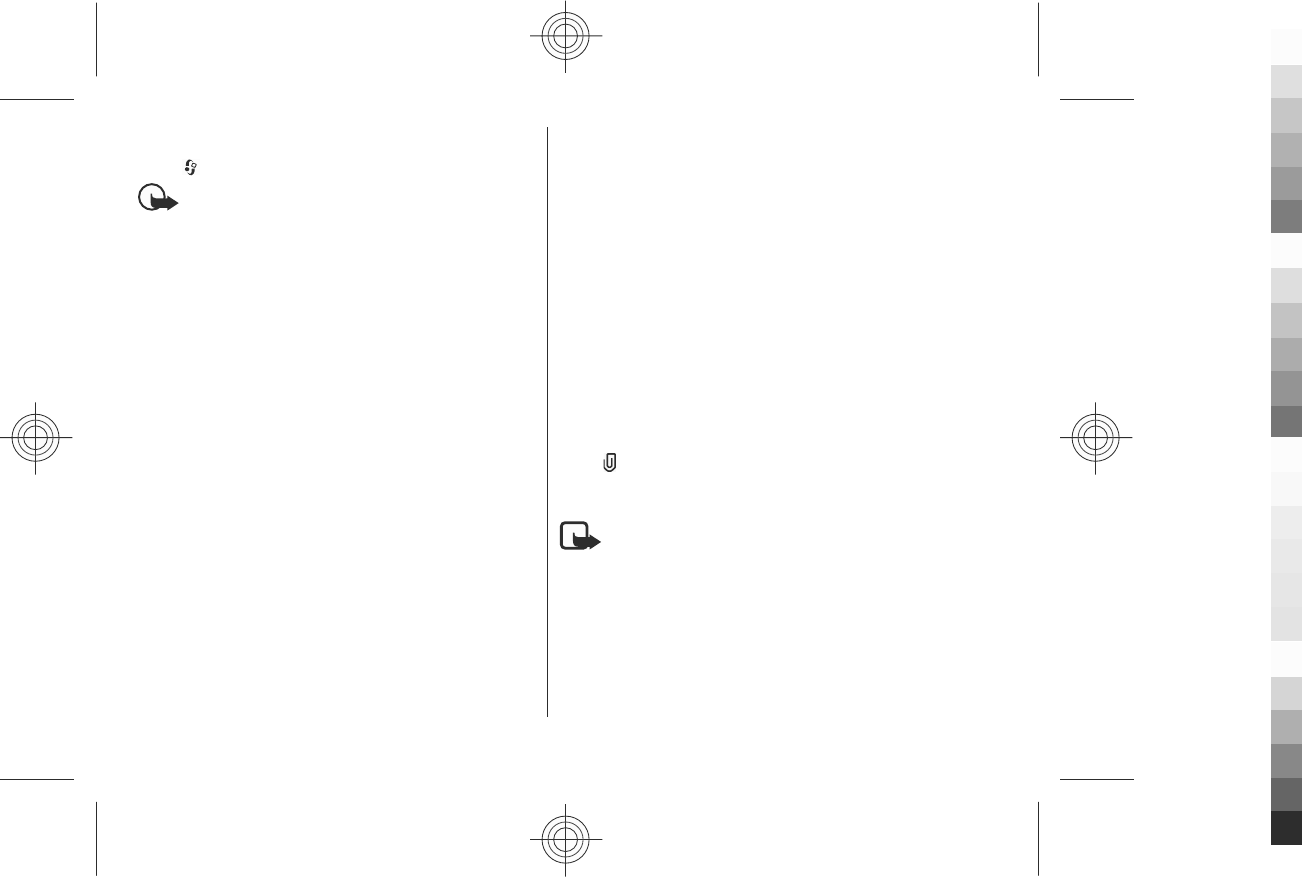
Write and send messages
Select > Messaging.
Important: Exercise caution when opening
messages. Messages may contain malicious software or
otherwise be harmful to your device or PC.
Before you can create a multimedia message or write an
e-mail, you must have the correct connection settings in
place.
The wireless network may limit the size of MMS messages.
If the inserted picture exceeds this limit, the device may
make it smaller so that it can be sent by MMS.
Check the size limit of e-mail messages with your service
provider. If you attempt to send an e-mail message that
exceeds the size limit of the e-mail server, the message is
left in the Outbox folder, and the device attempts to resend
it periodically. Sending an e-mail requires a data
connection, and continuous attempts to resend the e-mail
may increase your phone bill. In the Outbox folder, you can
delete such a message, or move it to the Drafts folder.
1. Select New message > Message to send a text or
multimedia message (MMS), Audio message to send
a multimedia message that includes one sound clip, or
E-mail to send an e-mail message.
2. In the To field, press the scroll key to select recipients
or groups from the contacts list, or enter the recipient’s
phone number or e-mail address. To add a semicolon
(;) that separates the recipients, press *. You can also
copy and paste the number or address from the
clipboard.
3. In the subject field, enter the subject of the e-mail. To
change the fields that are visible, select Options >
Message header fields.
4. In the message field, write the message. To insert a
template or note, select Options > Insert content >
Insert text > Template or Note.
5. To add a media file to a multimedia message, select
Options > Insert content, the file type or source, and
the desired file. To insert a business card, slide, note,
or some other file to the message, select Options >
Insert content > Insert other.
6. To capture an image or record a video or sound clip for
a multimedia message, select Options > Insert
content > Insert image > New, Insert video
clip > New, or Insert sound clip > New.
7. To add an attachment to an e-mail, select Options and
the attachment type. E-mail attachments are indicated
by .
8. To send the message, select Options > Send, or press
the call key.
Note: The message sent icon or text on your device
screen does not indicate that the message is received at
the intended destination.
Your device supports text messages beyond the limit for a
single message. Longer messages are sent as two or more
messages. Your service provider may charge accordingly.
Characters with accents, other marks, or some language
options take more space, and limit the number of
characters that can be sent in a single message.
21
Your Nokia XXXX
Cyan
Cyan
Magenta
Magenta XYellow
Black
Black
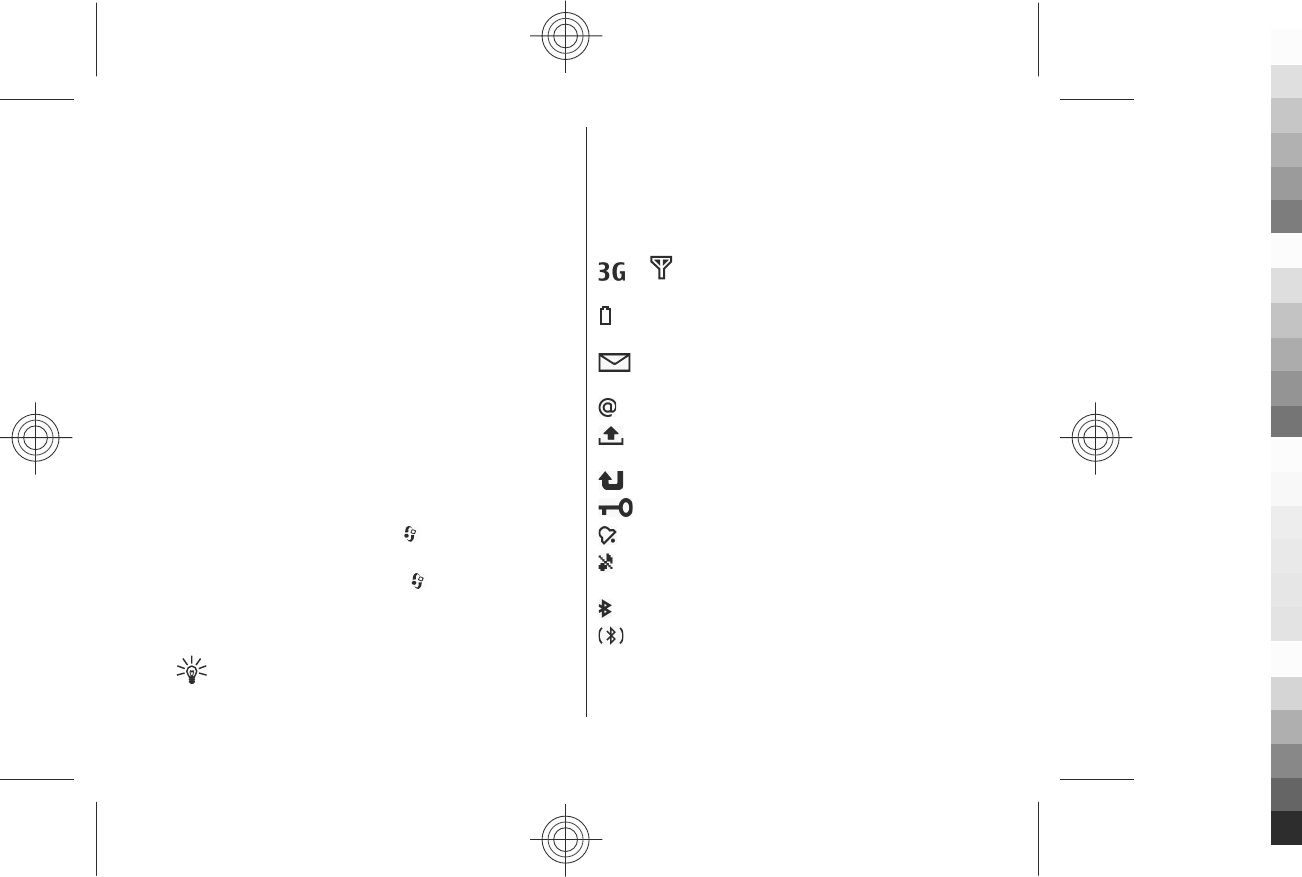
You may not be able to send video clips that are saved in
the MP4 file format or that exceed the size limit of the
wireless network in a multimedia message.
Active standby
When you have switched on the device, and it is registered
to a network, the device is in the standby mode and ready
for use.
To open the list of last dialled numbers, press the call key.
Scroll left to access a list of received and missed calls.
To use voice commands or voice dialling, press and hold
the right selection key.
To change the profile, press the power key, and select a
profile.
To connect to the web, press the internet key.
Menu
The main menu is a starting point from which you can
open all applications in the device or on a memory card.
To access the main menu, press .
To open an application or a folder, select the item.
To change the menu view, select > Options >
Change Menu view and a view type.
To close an application or a folder, select Back and Exit as
many times as needed to return to the standby mode.
Tip: To display and switch between open
applications, press and hold the menu key, and
select an application. To close an application, press
the backspace key.
Leaving applications running in the background increases
the demand of battery power and reduces the battery life.
Indicators
or The device is connected to a UMTS or GSM
network.
The battery charge level. The higher the bar, the
stronger the charge in the battery.
You have one or more unread messages in the Inbox
folder in Messaging.
You have received new e-mail in the remote mailbox.
There are messages waiting to be sent in the Outbox
folder in Messaging.
You have one or more missed phone calls.
The keys of the device are locked.
An alarm is active.
You have activated the Silent profile, and the device
does not ring for an incoming call or message.
Bluetooth connectivity is activated.
A Bluetooth connection is established. When the
indicator is blinking, your device is trying to connect with
another device.
22
Your Nokia XXXX
Cyan
Cyan
Magenta
Magenta
Yellow
Yellow
Black
Black
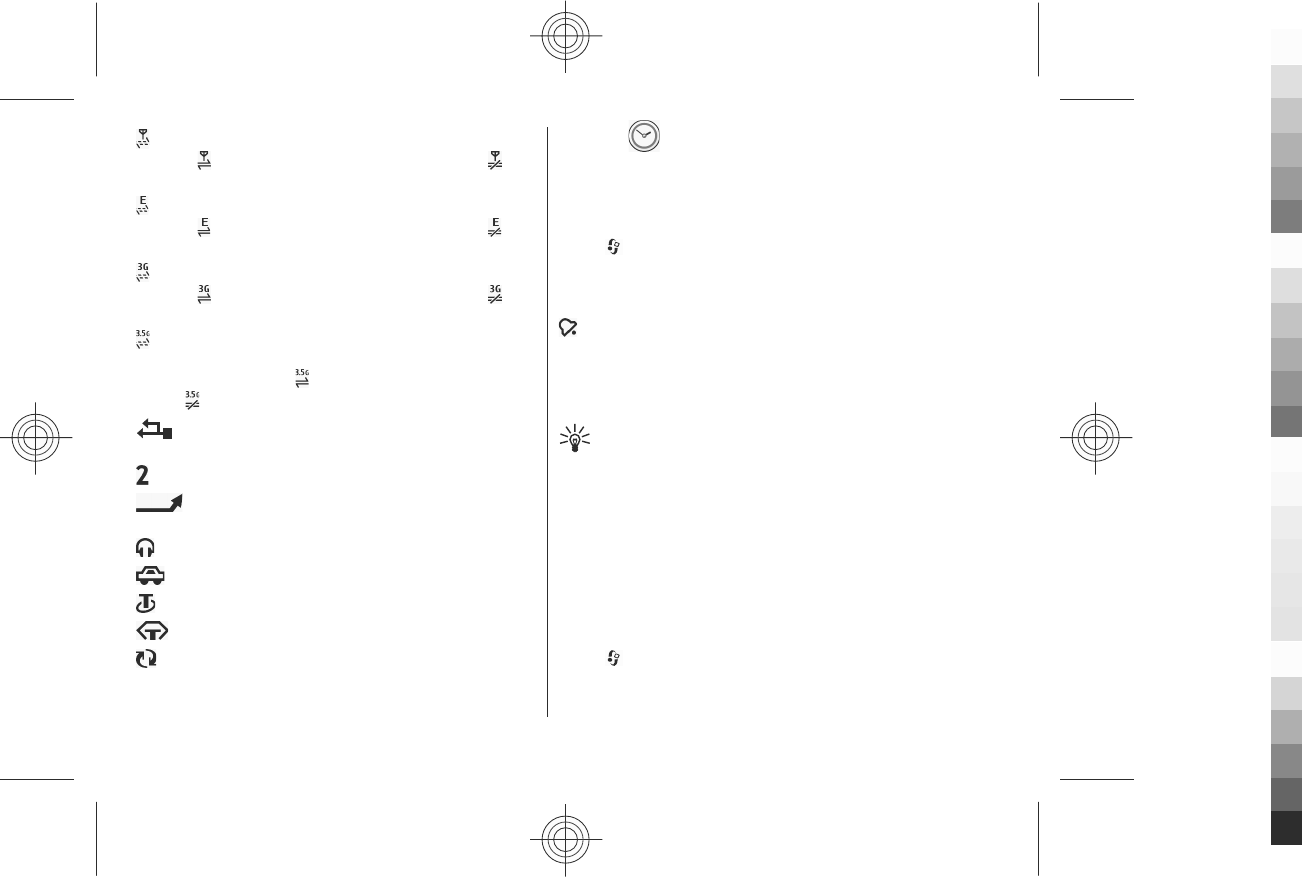
A GPRS packet data connection is available (network
service). indicates that the connection is active.
indicates that the connection is on hold.
An EGPRS packet data connection is available (network
service). indicates that the connection is active.
indicates that the connection is on hold.
A UMTS packet data connection is available (network
service). indicates that the connection is active.
indicates that the connection is on hold.
High-speed downlink packet access (HSDPA) is
supported and available (network service). The icon may
vary between regions. indicates that the connection is
active. indicates that the connection is on hold.
Your device is connected to a computer with a USB
data cable.
The second phone line is being used (network service).
All calls are forwarded to another number. If you
have two phone lines, a number indicates the active line.
A headset is connected to the device.
A handsfree car kit is connected to the device.
A loopset is connected to the device.
A text phone is connected to the device.
Your device is synchronising.
Clock
With Clock, you can view your local time or time in other
cities, and use your device as an alarm clock.
Alarm clock
Select > Applications > Clock.
To view your active and inactive alarms, open the alarms
tab. To set a new alarm, select Options > New alarm.
Define the repetition, if needed. When an alarm is active,
is displayed.
To turn off the sounding alarm, select Stop. To stop the
alarm for a certain time period, select Snooze. If your
device is switched off when an alarm is due, your device
switches itself on and starts sounding the alarm tone.
Tip: To define the time period after which the alarm
sounds again when you set it to snooze, select
Options > Settings > Alarm snooze time.
To cancel an alarm, select Options > Remove alarm.
To change the time, date, and clock type settings, select
Options > Settings.
To automatically update the time, date, and time zone
information to your device (network service), select
Options > Settings > Automatic time update > On.
World clock
Select > Applications > Clock.
To view the time in different locations, open the world
clock tab. To add locations to the list, select Options >
23
Your Nokia XXXX
Cyan
Cyan
Magenta
Magenta
Yellow
Yellow
Black
Black
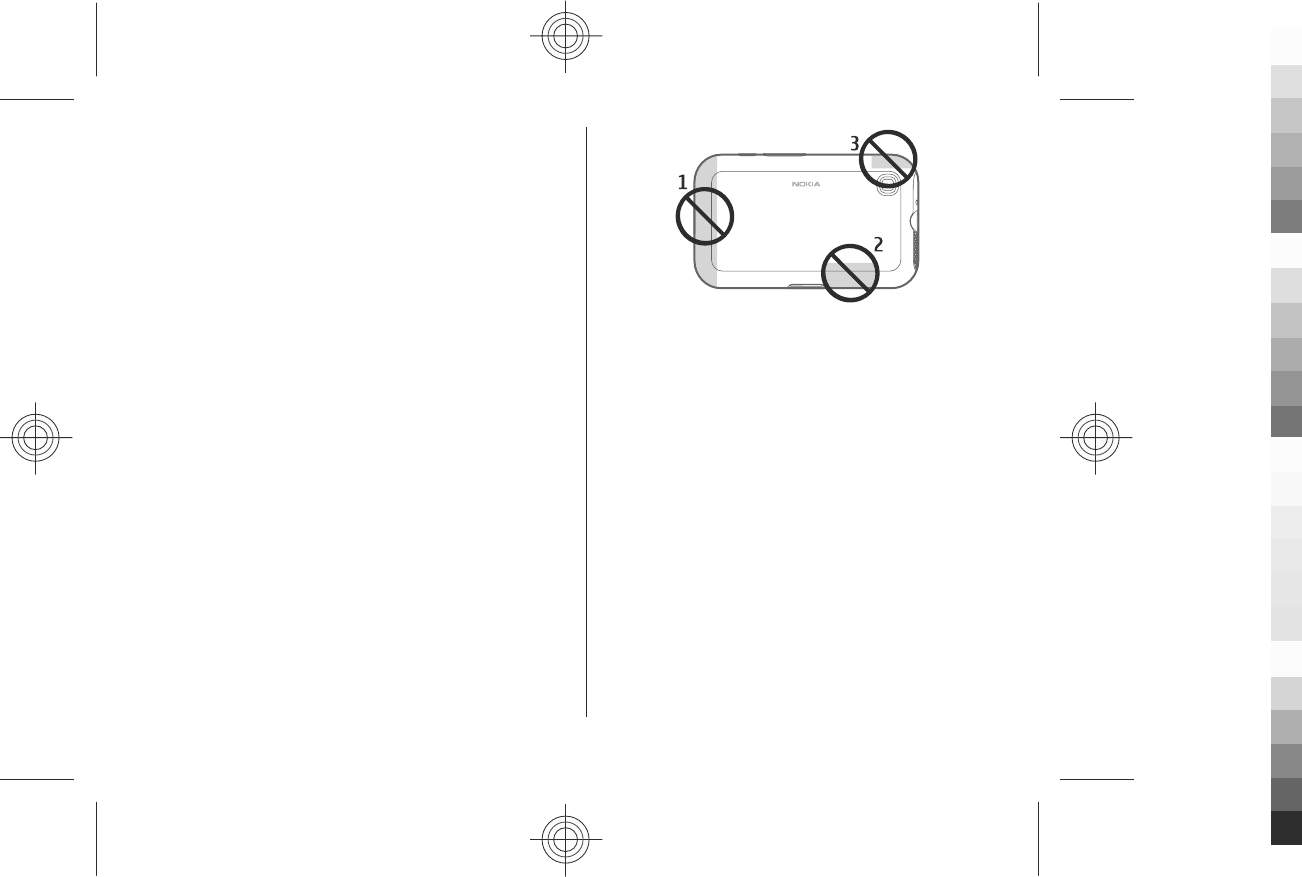
Add location. You can add a maximum of 15 locations to
the list.
To set your current location, scroll to a location, and select
Options > Set as current location. The location is
displayed in the clock main view, and the time in your
device is changed according to the selected location.
Ensure that the time is correct and matches your time
zone.
Clock settings
Select Options > Settings.
To change the time or date, select Time or Date.
To change the clock shown in the standby modes, select
Clock type > Analogue or Digital.
To allow the mobile phone network to update the time,
date, and time zone information to your device (network
service), select Automatic time update > On.
To change the alarm tone, select Clock alarm tone.
Antenna locations
Your device has three integrated antennas: cellular
antenna, Bluetooth antenna, and GPS antenna.
Your device may have internal and external antennas.
Avoid touching the antenna area unnecessarily while the
antenna is transmitting or receiving. Contact with
antennas affects the communication quality and may
cause a higher power level during operation and may
reduce the battery life.
24
Your Nokia XXXX
Cyan
Cyan
Magenta
Magenta
Yellow
Yellow
Black
Black

4. Personalise your device
You can personalise your device by, for example, adjusting
the various tones, and changing the background image
and screen saver.
Profiles
Select > Tools > Profiles.
You can adjust and customise the ringing tones, alert
tones, and other device tones for different events,
environments, or caller groups. The active profile is shown
at the top of the display in the standby mode. However, if
the active profile is General, only today's date is shown.
To create a new profile, select Options > Create new,
and define the settings.
To customise a profile, select a profile and Options >
Personalise.
To change a profile, select a profile and Options >
Activate. The Offline profile prevents your device from
accidentally switching on, sending or receiving messages,
or using Bluetooth connectivity, GPS, or FM radio; it also
closes any internet connection that may be in operation
when the profile is selected. The Offline profile does not
prevent you from establishing a Bluetooth connection at
a later time, or from restarting the GPS or FM radio, so
comply with any applicable safety requirements when
establishing and using these features.
To set the profile to be active until a certain time within
the next 24 hours, scroll to the profile, select Options >
Timed, and set the time. When the time expires, the
profile changes back to the previously active non-timed
profile. When the profile is timed, is displayed in the
standby mode. The Offline profile cannot be timed.
To delete a profile that you created, select Options >
Delete profile. You cannot delete the predefined profiles.
Select ringing tones
To set a ringing tone for a profile, select Options >
Personalise > Ringing tone. Select a ringing tone from
the list, or select Download sounds to open a bookmark
folder containing a list of bookmarks for downloading
tones using the browser. Any downloaded tones are saved
to Gallery.
To play the ringing tone for a selected contact group only,
select Options > Personalise > Alert for, and select the
desired group. Phone calls coming from outside that
group have a silent alert.
To change the message tone, select Options >
Personalise > Message alert tone.
Change the display theme
Select > Tools > Themes.
To change the theme used in all applications, select
General.
To change the theme used in the main menu, select Menu
view.
25
Personalise your device
Cyan
Cyan
Magenta
Magenta
Yellow
Yellow
Black
Black

To change the theme for a particular application, select
the application-specific folder.
To change the background image of the home screen,
select Wallpaper.
To select an animation for the screen saver, select Power
saver.
To turn theme effects on or off, select General >
Options > Theme effects.
26
Personalise your device
Cyan
Cyan
Magenta
Magenta
Yellow
Yellow
Black
Black
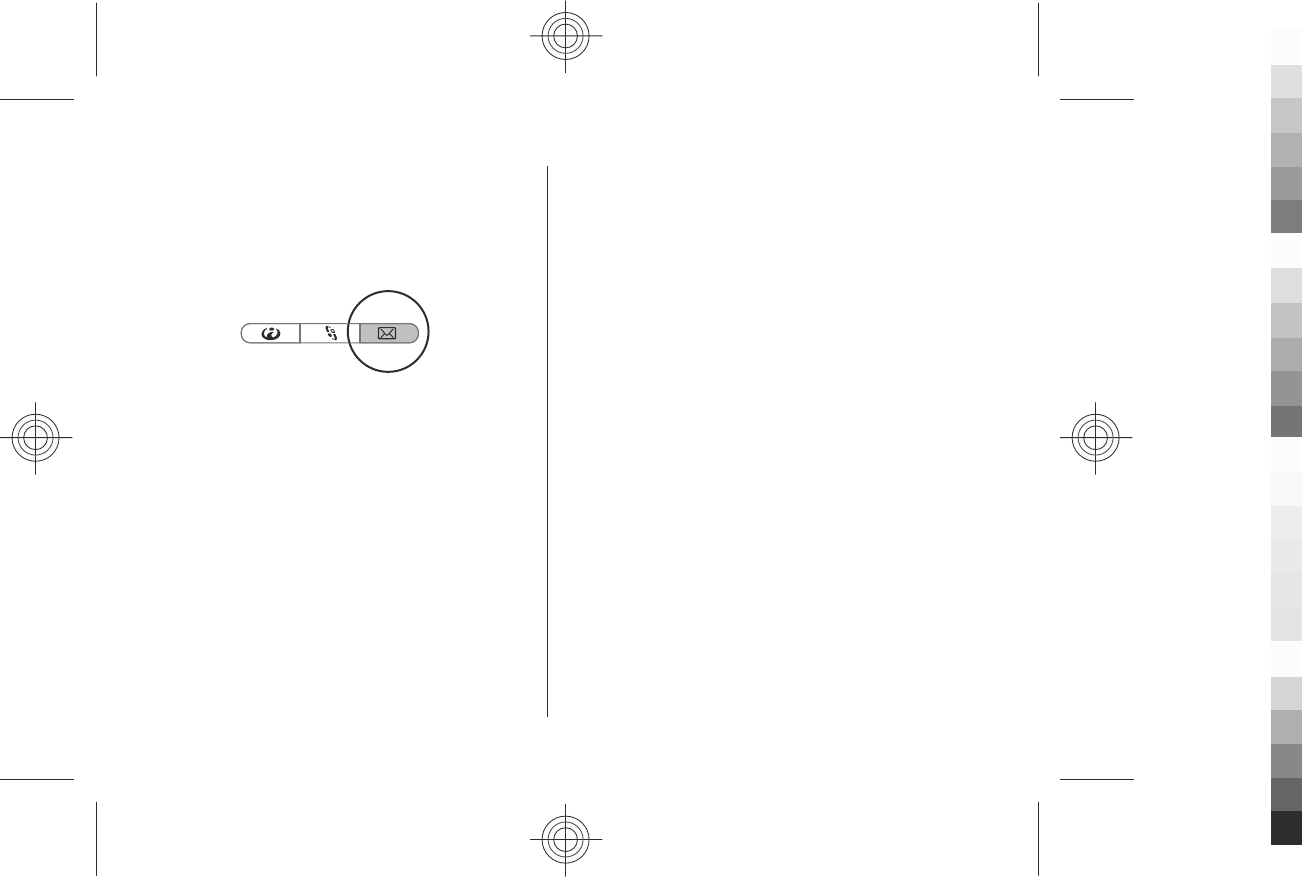
5. E-mail and instant messaging
With your device, you can read and reply to both personal
and work e-mail, and chat with your instant messaging
contacts.
Messaging key
Your device has a key for quick access to your messages.
Ovi Mail
If you do not yet have an e-mail account, or want to create
another one, Ovi Mail offers you that possibility. Ovi Mail
is a free e-mail service that you can use from the web or
directly from your device.
For more information, see http://mail.ovi.com.
This service may not be available in all regions or
languages.
Mail for Exchange
With Mail for Exchange, you can receive your work e-mail
to your device. You can read and reply to your e-mails, view
and edit compatible attachments, view calendar
information, receive and reply to meeting requests,
schedule meetings, and view, add, and edit contact
information. Mail for Exchange can be set up only if your
company has Microsoft Exchange Server. In addition, your
company's IT administrator must have activated Mail for
Exchange for your account.
Before starting to set up Mail for Exchange, ensure that you
have the following:
●A corporate e-mail ID
●Your office network user name
●Your office network password
●Your network domain name (contact your company's IT
department)
●Your Mail for Exchange server name (contact your
company's IT department)
Depending on your company's Mail for Exchange server
configuration, you may need to enter other information in
addition to those listed. If you do not know the correct
information, contact your company's IT department.
With Mail for Exchange, the use of the lock code may be
mandatory. The default lock code of your device is 12345,
but your company's IT administrator may have set a
different one for you to use.
You can access and modify the Mail for Exchange profile
and settings in the Messaging settings.
Chat
With the instant messaging (IM) network service, you can
send short, simple text messages to online users. You have
27
E-mail and instant messaging
Cyan
Cyan
Magenta
Magenta
Yellow
Yellow
Black
Black

to subscribe to a service and register with the IM service
you want to use.
28
E-mail and instant messaging
Cyan
Cyan
Magenta
Magenta
Yellow
Yellow
Black
Black

6. Nokia Maps
Need directions? Looking for a restaurant? Your device has
the tools to get you where you want to be.
Positioning (GPS)
You can use applications such as GPS data to determine
your location, or measure distances and coordinates.
These applications require a GPS connection.
About GPS
The coordinates in the GPS are expressed in the degrees
and decimal degrees format using the international
WGS-84 coordinate system. The availability of the
coordinates may vary by region.
The Global Positioning System (GPS) is operated by the
government of the United States, which is solely
responsible for its accuracy and maintenance. The
accuracy of location data can be affected by adjustments
to GPS satellites made by the United States government
and is subject to change with the United States
Department of Defense civil GPS policy and the Federal
Radionavigation Plan. Accuracy can also be affected by
poor satellite geometry. Availability and quality of GPS
signals may be affected by your location, buildings,
natural obstacles, and weather conditions. GPS signals
may not be available inside buildings or underground and
may be impaired by materials such as concrete and metal.
GPS should not be used for precise location measurement,
and you should never rely solely on location data from the
GPS receiver and cellular radio networks for positioning or
navigation.
The trip meter has limited accuracy, and rounding errors
may occur. Accuracy can also be affected by availability
and quality of GPS signals.
Different positioning methods can be enabled or disabled
in positioning settings.
Assisted GPS (A-GPS)
Your device also supports assisted GPS (A-GPS).
A-GPS is requires network support.
Assisted GPS (A-GPS) is used to retrieve assistance data
over a packet data connection, which assists in calculating
the coordinates of your current location when your device
is receiving signals from satellites.
When you activate A-GPS, your device receives useful
satellite information from an assistance data server over
the cellular network. With the help of assisted data, your
device can obtain the GPS position faster.
Your device is preconfigured to use the Nokia A-GPS
service, if no service provider-specific A-GPS settings are
available. The assistance data is retrieved from the Nokia
A-GPS service server only when needed.
To disable the A-GPS service, select > Applications >
GPS data and Options > Positioning settings >
Positioning methods > Assisted GPS > Disable.
You must have an internet access point defined in the
device to retrieve assistance data from the Nokia A-GPS 29
Nokia Maps
Cyan
Cyan
Magenta
Magenta
Yellow
Yellow
Black
Black
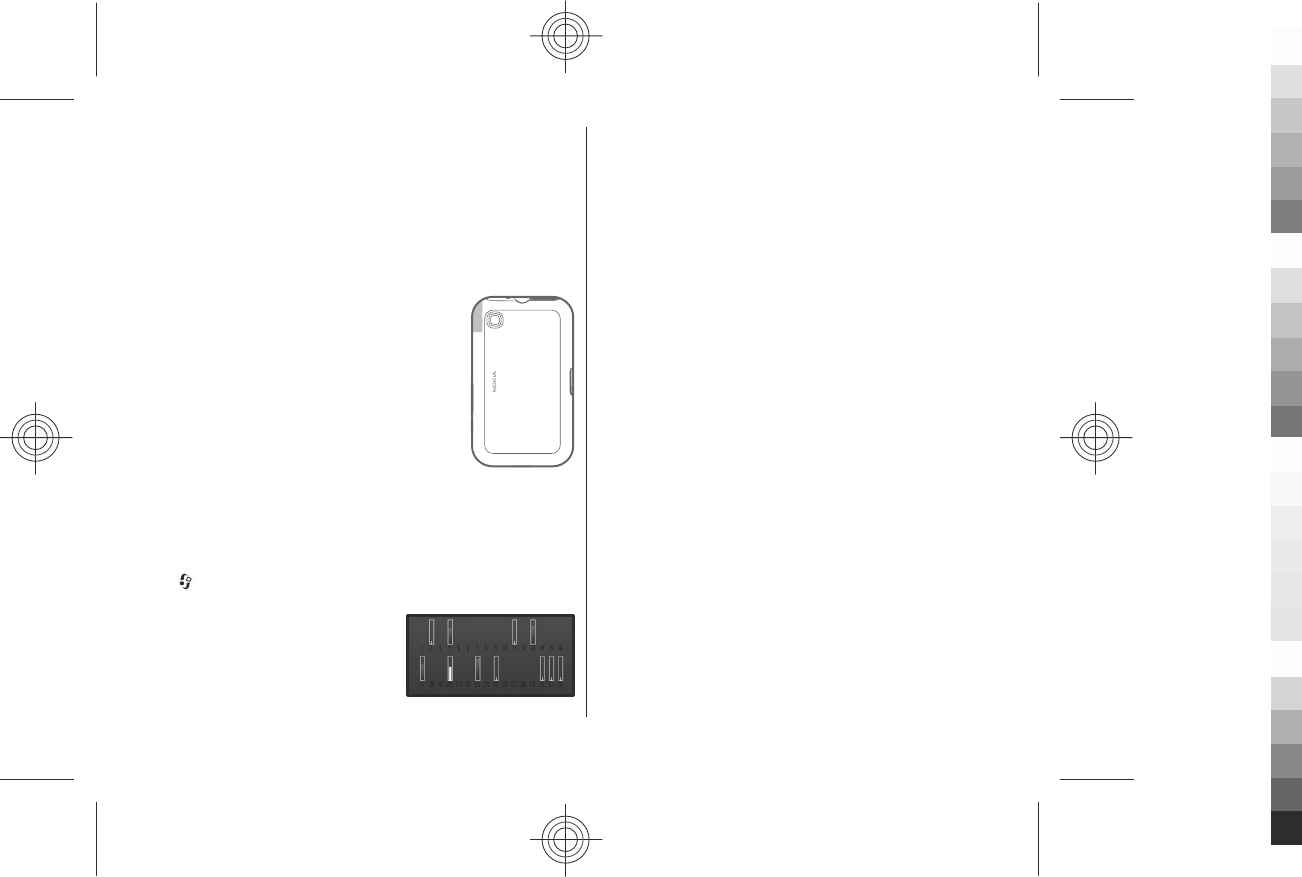
service over a packet data connection. The access point for
A-GPS can be defined in positioning settings. Only a packet
data internet access point can be used. Your device asks
you to select the internet access point when GPS is used
for the first time.
Hold your device correctly
When using the GPS receiver, ensure you do not cover the
antenna with your hand.
Establishing a GPS connection may take
from a couple of seconds to several
minutes. Establishing a GPS connection in
a vehicle may take longer.
The GPS receiver draws its power from the
device battery. Using the GPS receiver
may drain the battery faster.
Tips on creating a GPS connection
Check satellite signal status
To check how many satellites your device has found, and
whether your device is receiving satellite signals, select
> Applications and GPS data > Position >
Options > Satellite status.
If your device has found
satellites, a bar for each satellite
is shown in the satellite info
view. The longer the bar, the
stronger the satellite signal.
When your device has received enough data from the
satellite signal to calculate the coordinates of your
location, the bar turns blue.
To view the positions of found satellites, select Chg.
view.
Initially your device must receive signals from at least four
satellites to be able to calculate the coordinates of your
location. When the initial calculation has been made, it
may be possible to continue calculating the coordinates of
your location with three satellites. However, the accuracy
is generally better when more satellites are found.
If your device cannot find the satellite signal, consider the
following:
●If you are indoors, go outdoors to receive a better
signal.
●If you are outdoors, move to a more open space.
●Ensure that your hand does not cover the GPS antenna
of your device.
●If the weather conditions are bad, the signal strength
may be affected.
●Some vehicles have tinted (athermic) windows, which
may block the satellite signals.
About Maps
With Maps, you can see your current location on the map,
browse maps of different cities and countries, search for
places, plan routes from one location to another, save
locations, and send them to compatible devices. You can
30
Nokia Maps
Cyan
Cyan
Magenta
Magenta
Yellow
Yellow
Black
Black

also purchase licences for traffic information and
navigation services, if available for your country or region.
When you use Maps for the first time, you may need to
select an internet access point for downloading maps.
If you browse to an area which is not covered by maps
already downloaded in your device, a map for the area is
automatically downloaded through the internet. Some
maps may be available in your device or on a memory card.
You can also use the Nokia Map Loader PC software to
download maps. To install Nokia Map Loader to a
compatible PC, see www.nokia.com/maps.
Tip: To avoid data transfer costs, you can also use
Maps without an internet connection, and browse
the maps that are saved in your device or memory
card.
Note: Downloading content such as maps, satellite
images, voice files, guides or traffic information may
involve transmission of large amounts of data (network
service).
Almost all digital cartography is inaccurate and
incomplete to some extent. Never rely solely on the
cartography that you download for use in this device.
Move on a map
When the GPS connection is active, shows your current
location on the map.
To view your current or last known location, select
Options > My position.
To move on the map, scroll up, down, left, or right with
the scroll key. The map is oriented towards north by
default.
When you have an active data connection and browse the
map on the display, a new map is automatically
downloaded if you scroll to an area not covered by the
maps that have already been downloaded. The maps are
automatically saved in the device memory or on a
compatible memory card, if inserted.
To zoom in and out on the map, press the left and right
shift keys, or the shift key and the backspace key,
depending on the keyboard of your device.
To change the map type, select Options > Map mode.
Plan a route
To plan a route, scroll to your start point on the map, press
the scroll key, and select Add to route. To add the
destination and more locations to the route, select Add
new route point. If you want to use your current position
as the starting point, add the destination to the route.
To change the order of the locations in the route, scroll to
a location, press the scroll key, and select Move. Scroll to
the place where you want to move the location, and select
Select.
To edit the route, press the scroll key, and select Edit
route.
To show the route on the map, select Show route.
31
Nokia Maps
Cyan
Cyan
Magenta
Magenta
Yellow
Yellow
Black
Black

To navigate to the destination by car or on foot, if you have
purchased a licence for these services, select Show
route > Options > Start driving or Start walking.
To save the route, select Show route > Options > Save
route.
Navigate to the destination
To navigate to your destination, you must purchase a
licence for the navigation service.
To purchase a licence for pedestrian and car navigation,
select Options > Shop & Licenses > Drive & Walk. To
purchase a licence for pedestrian navigation only, select
Walk. The licence is region-specific and can be used only
in the selected area. You can pay for the licence through a
credit card or in your phone bill, if supported by your
service provider. You can transfer the licence from your
device to another compatible device, but the licence can
only be used in one device at a time.
When you use car navigation for the first time, you are
asked to select the language of the voice guidance and
download the related voice guidance files. To change the
language later, in the main view, select Options >
Tools > Settings > Navigation > Voice guidance.
Voice guidance is not available for pedestrian navigation.
To start navigating, scroll to a location, press the scroll key,
and select Drive to or Walk to.
To stop navigating, select Stop.
32
Nokia Maps
Cyan
Cyan
Magenta
Magenta
Yellow
Yellow
Black
Black
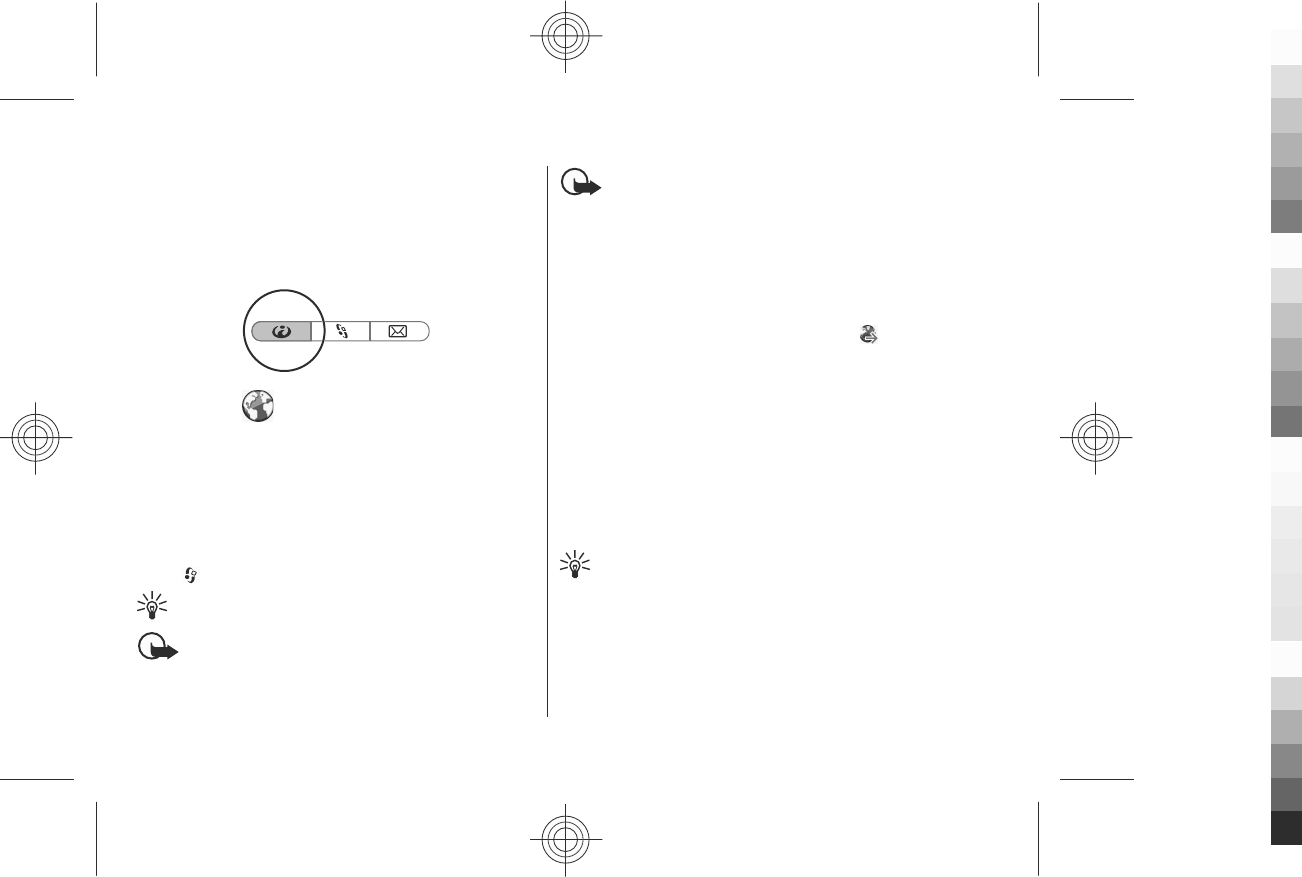
7. Internet and connectivity
You can browse the internet, or connect your device to a
compatible computer, using the various connectivity
methods of your device.
Internet key
Your device has a key for accessing the web quickly.
Browser
With the Browser application, you can view web pages on
the internet. You can also browse web pages that are
designed specifically for mobile devices.
To browse the web, you need to have an internet access
point configured in your device.
Browse the web
Select > Web.
Shortcut: To open the browser, press the internet
key.
Important: Use only services that you trust and
that offer adequate security and protection against
harmful software.
Important: Only install and use applications and
other software from trusted sources, such as applications
that are Symbian Signed or have passed the Java
Verified™ testing.
The homepage opens. To change the homepage, select
Options > Settings.
To browse a web page, in the bookmarks view, select a
bookmark, or enter the address in the field ( ), and press
the scroll key.
Some web pages may contain material, such as graphics
and sounds, that require a large amount of memory to
view. If your device runs out of memory while loading such
a web page, the graphics on the page are not displayed.
To browse web pages without graphics, to save memory,
select Options > Settings > Page > Load content >
Text only.
To enter a new web address, select Options > Go to web
address.
Tip: While browsing, to open a bookmark, press 1,
and select a bookmark.
To refresh the content of the web page, select Options >
Navigation options > Reload.
To save the current web page as a bookmark, select
Options > Save as bookmark.
To view snapshots of the web pages you have visited
during the current browsing session, select Back 33
Internet and connectivity
Cyan
Cyan
Magenta
Magenta
Yellow
Yellow
Black
Black

(available if History list is activated in the browser
settings and the current web page is not the first web page
you visit). Select the web page to return to.
To save a web page while browsing, select Options >
Tools > Save page.
You can save web pages and browse them later when
offline. You can also group web pages into folders. To
access the web pages you have saved, in the bookmarks
view, select Saved pages.
To open a sublist of commands or actions for the current
web page, select Options > Service options (if
supported by the web page).
To prevent or allow the automatic opening of multiple
windows, select Options > Window > Block pop-ups
or Allow pop-ups.
Tip: To return to the home screen with the browser
open in the background, press twice or the end
key. To return to the browser, press and hold ,
and select the browser.
Web feeds and blogs
Web feeds are XML files on web pages that are used to
share, for example, the latest news headlines or blogs.
Blogs or weblogs are web diaries. It is common to find web
feeds on web, blog, and wiki pages.
The Web application automatically detects if a web page
contains web feeds.
To subscribe to a web feed, select a feed and Options >
Subscribe to web feeds.
To update a web feed, select a feed and Options >
Refresh.
To define how the web feeds are updated, select
Options > Settings > Web feeds.
Empty the cache
The information or services you have accessed are stored
in the cache memory of the device.
A cache is a memory location that is used to store data
temporarily. If you have tried to access or have accessed
confidential information requiring passwords, empty the
cache after each use. The information or services you have
accessed are stored in the cache.
To empty the cache, select Options > Clear privacy
data > Cache.
End the connection
To end the connection and view the browser page offline,
select Options > Tools > Disconnect; or to end the
connection and close the browser, select Options >
Exit.
To take the browser to the background, press the end key
once. To end the connection, press and hold the end key.
To delete the information the network server collects
about your visits to various web pages, select Options >
Clear privacy data > Cookies.
34
Internet and connectivity
Cyan
Cyan
Magenta
Magenta
Yellow
Yellow
Black
Black
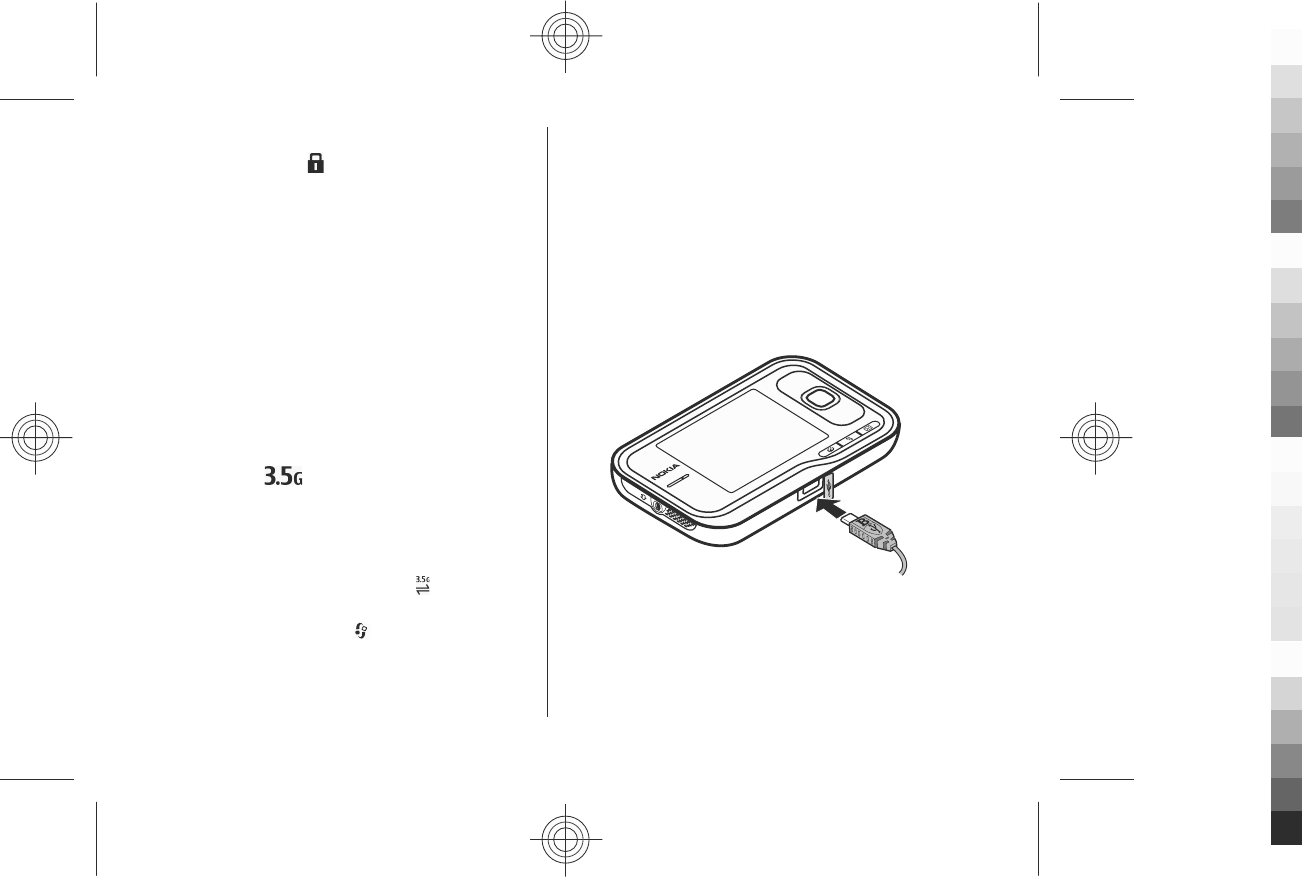
Connection security
If the security indicator ( ) is displayed during a
connection, the data transmission between the device and
the internet gateway or server is encrypted.
The security icon does not indicate that the data
transmission between the gateway and the content server
(where the data is stored) is secure. The service provider
secures the data transmission between the gateway and
the content server.
Security certificates may be required for some services,
such as banking services. You are notified if the identity of
the server is not authentic or if you do not have the correct
security certificate in your device. For more information,
contact your service provider.
Fast downloading
High-speed downlink packet access (HSDPA, also called
3.5G, indicated by ) is a network service in UMTS
networks and provides high-speed data downloads. When
HSDPA support in the device is activated and the device is
connected to a UMTS network that supports HSDPA,
downloading data such as messages, e-mail, and browser
pages through the cellular network may be faster. An
active HSDPA connection is indicated by . The icon may
vary between regions.
To turn HSDPA on or off, select > Tools > Settings
and Connection > Packet data > High speed packet
access. Some cellular networks do not allow incoming
voice calls when HSDPA is active, in which case you need
to deactivate HSDPA to receive calls. For more information,
contact your service provider.
For availability and subscription to data connection
services, contact your service provider.
HSDPA only affects the download speed; sending data to
the network, such as messages and e-mail, is not affected.
Connect the USB data cable
The USB connector is behind a cover.
The USB data cable is for data transfer only and does not
support charging.
To avoid corrupting data, do not disconnect the USB data
cable during data transfer.
Transfer data between your device and a PC
1. Insert a memory card in your device, and connect the
device to a compatible PC with the data cable.
35
Internet and connectivity
Cyan
Cyan
Magenta
Magenta
Yellow
Yellow
Black
Black
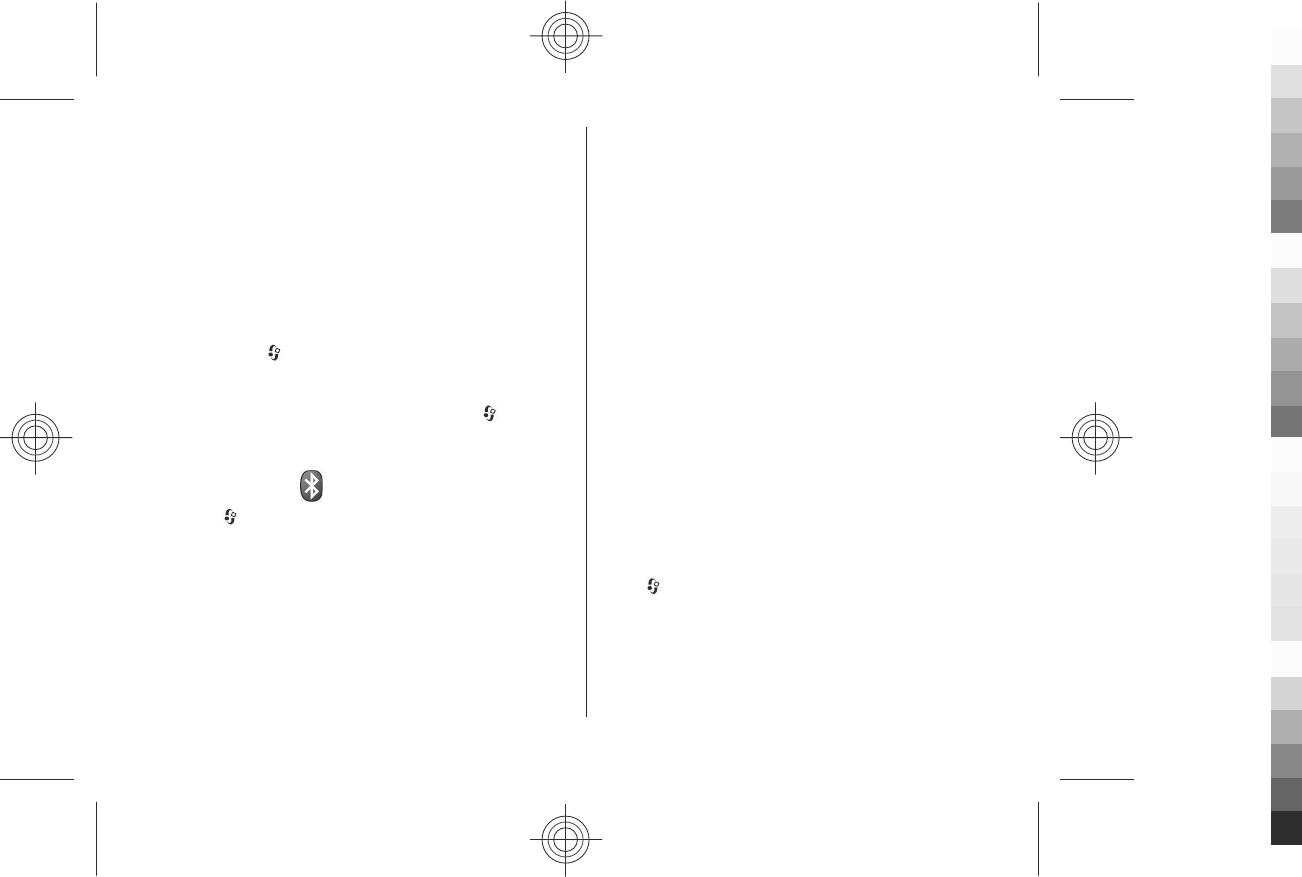
2. When the device asks which mode to use, select Mass
storage. In this mode, you can see your device as a
removable hard drive in your computer.
3. End the connection from the computer (from the
Unplug or Eject Hardware wizard in Microsoft
Windows, for example) to avoid damaging the
memory card.
To use Nokia PC Suite with your device, install Nokia PC
Suite on your PC, connect the data cable, and select PC
Suite.
To change the USB mode you normally use with the data
cable, select > Settings > Connectivity > USB and
USB connection mode, and the desired option.
To set the device to ask for the mode each time you
connect the data cable to the device, select >
Settings > Connectivity > USB and Ask on
connection > Yes.
Bluetooth
Select > Tools > Connectivity > Bluetooth.
About Bluetooth
Bluetooth technology in your device enables wireless
connections between electronic devices within a range of
10 metres (33 feet). A Bluetooth connection can be used
to send images, videos, text, business cards, calendar
notes, or to connect wirelessly to devices that use
Bluetooth technology.
Since devices using Bluetooth technology communicate
using radio waves, your device and the other devices do
not need to be in direct line-of-sight. The two devices only
need to be within a maximum of 10 metres of each other,
although the connection can be subject to interference
from obstructions such as walls or other electronic
devices.
Several Bluetooth connections can be active at a time. For
example, if your device is connected to a headset, you can
also transfer files to another compatible device at the
same time.
This device is compliant with Bluetooth Specification 2.0
+ EDR supporting the following profiles: advanced audio
distribution, audio/video remote control, basic imaging,
device identification, dial-up networking, file transfer,
generic audio/video distribution, generic object
exchange, hands-free, headset, human interface device,
object push, phone book access, and SIM access. To ensure
interoperability between other devices supporting
Bluetooth technology, use Nokia approved accessories for
this model. Check with the manufacturers of other devices
to determine their compatibility with this device.
Features using Bluetooth technology increase the demand
on battery power and reduce the battery life.
Send and receive data with Bluetooth
Select > Tools > Connectivity > Bluetooth.
1. When you activate Bluetooth connectivity for the first
time, you are asked to name your device. Give your
device a unique name to make it easy to recognise if
there are several Bluetooth devices nearby.
2. Select Bluetooth > On.
36
Internet and connectivity
Cyan
Cyan
Magenta
Magenta
Yellow
Yellow
Black
Black

3. Select My phone's visibility > Shown to all or
Define period. If you select Define period, you need
to define the time during which your device is visible
to others. Your device and the name you entered can
now be seen by other users with devices using
Bluetooth technology.
4. Open the application where the item you want to send
is stored.
5. Select the item and Options > Send > Via
Bluetooth. The device searches for other devices using
Bluetooth technology within range and lists them.
Tip: If you have sent data using Bluetooth
connectivity before, a list of the previous search
results is displayed. To search for more
Bluetooth devices, select More devices.
6. Select the device with which you want to connect. If
the other device requires pairing before data can be
transmitted, you are asked to enter a passcode.
When the connection has been established, Sending
data is displayed.
The Sent folder in the Messaging application does not
store messages sent using Bluetooth connectivity.
To receive data using Bluetooth connectivity, select
Bluetooth > On and My phone's visibility > Shown to
all to receive data from a non-paired device or Hidden to
receive data from a paired device only. When you receive
data through Bluetooth connectivity, depending on the
settings of an active profile, a tone sounds, and you are
asked if you want to accept the message in which the data
is included. If you accept, the message is placed in the
Inbox folder in the Messaging application.
Tip: You can access the files in the device or on the
memory card using a compatible accessory that
supports the File Transfer Profile Client service (for
example, a laptop computer).
A Bluetooth connection is disconnected automatically
after sending or receiving data. Only Nokia PC Suite and
some accessories such as headsets may maintain a
connection even if not actively used.
Pair devices
Select > Tools > Connectivity > Bluetooth.
Open the paired devices tab.
Before pairing, decide on your own passcode (1-16 digits),
and agree with the user of the other device to use the same
code. Devices that do not have a user interface have a fixed
passcode. You need the passcode only when you connect
the devices for the first time. After pairing, it is possible to
authorise the connection. Pairing and authorising the
connection makes connecting quicker and easier, as you
do not have to accept the connection between paired
devices every time you establish a connection.
The passcode for remote SIM access must have 16 digits.
When the wireless device is in the remote SIM mode, you
can only use a compatible connected accessory, such as a
car kit, to make or receive calls.
Your wireless device will not make any calls, except to the
emergency numbers programmed into your device, while
in this mode.
37
Internet and connectivity
Cyan
Cyan
Magenta
Magenta
Yellow
Yellow
Black
Black

To make calls, you must first leave the remote SIM mode.
If the device has been locked, enter the lock code to unlock
it first.
1. Select Options > New paired device. The device
starts to search for Bluetooth devices within range. If
you have sent data using Bluetooth connectivity
before, a list of the previous search results is displayed.
To search for more Bluetooth devices, select More
devices.
2. Select the device with which you want to pair, and
enter the passcode. The same passcode must be
entered to the other device as well.
3. Select Yes to make the connection between your
device and the other device automatic, or No to
confirm the connection manually every time a
connection attempt is made. After pairing, the device
is saved to the paired devices page.
To give a nickname to the paired device, select Options >
Assign short name. The nickname is displayed in your
device.
To delete a pairing, select the device whose pairing you
want to delete and Options > Delete. To delete all
pairings, select Options > Delete all. If you are currently
connected to a device and cancel the pairing with that
device, pairing is removed immediately, and the
connection is ended.
To allow a paired device to connect automatically to your
device, select Set as authorised. Connections between
your device and the other device can be made without
your knowledge. No separate acceptance or authorisation
is needed. Use this status only for your own devices, such
as your compatible headset or computer, or devices that
belong to someone you trust. If you want to accept
connection requests from the other device separately
every time, select Set as unauthorised.
To use a Bluetooth audio accessory such as a Bluetooth
handsfree or headset, you need to pair your device with
the accessory. For the passcode and further instructions,
see the accessory user guide. To connect to the audio
accessory, switch on the accessory. Some audio
accessories connect automatically to your device.
Otherwise, open the paired devices tab, select the
accessory and Options > Connect to audio device.
Connection manager
Select > Tools > Connectivity > Conn. mgr..
View and end active connections
Select > Tools > Connectivity > Conn. mgr..
To view detailed information about network connections,
select a connection from the list and Options > Details.
The type of information shown depends on the connection
type.
To end the selected network connection, select Options >
Disconnect.
To end all active network connections simultaneously,
select Options > Disconnect all.
38
Internet and connectivity
Cyan
Cyan
Magenta
Magenta
Yellow
Yellow
Black
Black

8. Calendar and contacts
With Calendar, you can, for example, keep track of your
schedule, your friends' birthdays, or tasks that you need
to do. Select > Office > Calendar.
With Contacts, you can save and update contact
information, such as phone numbers, home addresses, or
e-mail addresses of your contacts. You can add a personal
ringing tone or an image to a contact card. You can also
create contact groups, which allow you to send text or e-
mail messages to many recipients at the same time. Select
> Contacts.
You can use the Switch application to copy contacts from
your previous Nokia device to your Nokia XXXX. See
"Transfer content", p. 18.
Create a calendar entry
1. To add a new calendar entry, scroll to the desired date,
select Options > New entry and from the following:
●Meeting — Add a reminder of your meeting.
●Meeting request — Create and send a new
meeting request. You must have a mailbox set up
for sending requests.
●Memo — Write a general note for the day.
●Anniversary — Add a reminder of birthdays or
special dates (entries are repeated annually).
●To-do — Add a reminder of a task that must be
done by a specific date.
2. To add a description to an entry, select Options > Add
description.
3. To save the entry, select Done.
Tip: In the day, week, or month calendar view, press
a key (0-9). An appointment entry opens, and the
characters you enter are added to the subject field.
In the to-do view, a to-do note entry opens.
When the calendar alarm sounds, select Silence to mute
the alarm.
To stop the calendar alarm, select Stop.
To set the alarm to snooze, select Snooze.
To define the period after which the calendar alarm
sounds again when set to snooze, select Options >
Settings > Alarm snooze time.
Calendar views
To switch between month, week, and to-do note view,
select Options > Month view, Week view, or To-do
view.
To change the starting day of the week, the view that is
shown when you open the calendar, or the calendar alarm
settings, select Options > Settings.
To go to a certain date, select Options > Go to date. To
go to today, press #.
Save and edit names and numbers
1. Press , and select Contacts > Options > New
contact.
39
Calendar and contacts
Cyan
Cyan
Magenta
Magenta
Yellow
Yellow
Black
Black

2. Fill in the fields that you want, and select Done.
To edit a contact card, select it, and Options > Edit. You
can also search for the desired contact by entering the first
letters of the name to the search field.
To attach an image to a contact card, open the contact
card, and select Options > Add image. The image is
shown when the contact calls.
Create contact groups
1. To create a new group, in the group list, select
Options > New group. Use the default name or enter
a new name. Select OK.
2. To add members to the group, select the group and
Options > Add members.
3. Mark each contact you want to add, and select OK.
Add ringing tones for contacts
Press , and select Contacts.
To define a ringing tone for a contact or a contact group:
1. Press the scroll key to open a contact card or go to the
groups list, and select a contact group.
2. Select Options > Ringing tone.
3. Select the ringing tone you want to use.
When a contact or group member calls you, the device
plays the selected ringing tone (if the caller’s phone
number is sent with the call and your device recognises it).
To remove the ringing tone, select Default tone from the
list of ringing tones.
40
Calendar and contacts
Cyan
Cyan
Magenta
Magenta
Yellow
Yellow
Black
Black
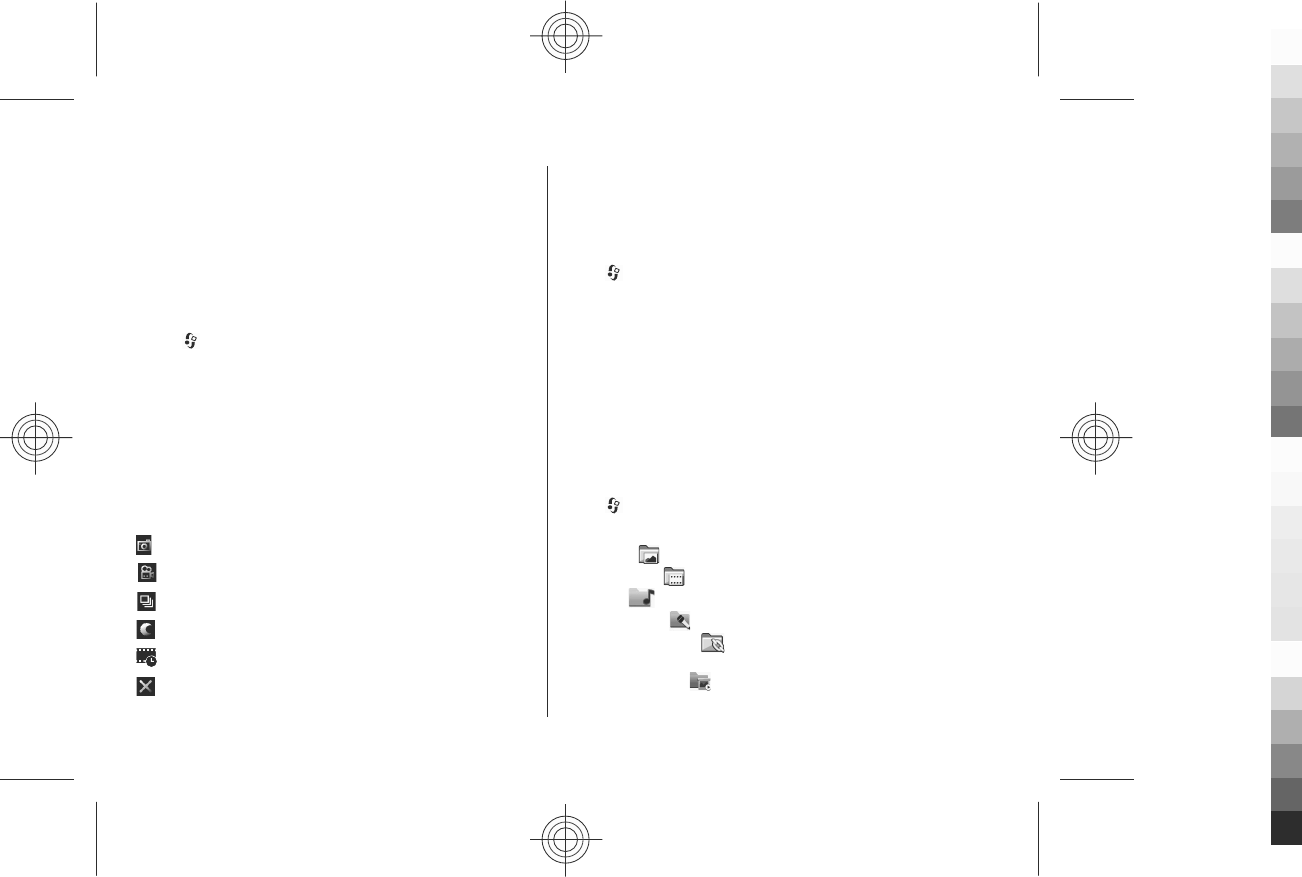
9. Images and music
With your Nokia XXXX, you can capture images, and
listen to music and radio.
Camera
When you use the camera, the display is automatically
rotated to landscape.
Capture an image
Select > Camera.
To capture an image, use the display as a viewfinder, and
press the capture key. The device saves the image in
Gallery.
To zoom in or out before capturing an image, use the scroll
key.
The toolbar provides you with shortcuts to different items
and settings before and after capturing an image or
recording a video clip. To view the toolbar, select
Options > Show toolbar. Select from the following:
Switch to image mode.
Switch to video mode.
Activate sequence mode (images only).
Switch to night mode (video only).
Video length.
Close the toolbar.
The available options vary depending on the capture mode
and view you are in. The settings return to the default
values when you close the camera.
Record videos
Select > Camera.
1. If the camera is in image mode, select video mode from
the toolbar.
2. To start recording, press the capture key.
3. To pause recording, select Pause. Select Continue to
resume recording.
4. To stop recording, select Stop. The video clip is
automatically saved in Gallery. The maximum length of
the video clip depends on the available memory.
Gallery
Select > Gallery.
Select from the following:
●Images — View images and videos in Photos.
●Video clips — View videos in Video centre.
●Songs — Open Music player.
●Sound clips — Listen to sound clips.
●Streaming links — View and open streaming
links.
●Presentations — View presentations.
41
Images and music
Cyan
Cyan
Magenta
Magenta
Yellow
Yellow
Black
Black

You can browse and open folders, and copy and move
items to folders. You can also create albums and copy and
add items to albums.
Files stored on your compatible memory card (if inserted)
are indicated with .
To open a file, press the scroll key. Video clips, RAM files,
and streaming links open and play in Video centre, and
music and sound clips in Music player.
To copy or move files to the memory card (if inserted) or
to device memory, select a file and Options > Move and
copy > Copy.
About Ovi Share
Ovi Share is an online service that helps you to share your
images, video clips, audio, and other media on your
computer or device with your family and friends. In Ovi
Share, you can tag and comment on images, create lists of
your favourites, and more. You must register to be able to
share, but no registration is required to view the media
that you share with others.
With your device, you can use the Share online application.
For more information, see share.ovi.com.
Music player
Select > Music > Music player.
Music player supports file formats such as AAC, AAC+, eAAC
+, MP3, and WMA. Music player does not necessarily
support all features of a file format or all the variations of
file formats.
You can also use Music player to listen to podcast episodes.
Podcasting is a method for delivering audio or video
content over the internet using either RSS or Atom
technologie,s for playback on mobile devices and PCs.
Play a song or a podcast episode
To add all available songs and podcasts to the music
library, select Options > Refresh library.
To play a song or a podcast episode, select the desired
category, and the song or podcast episode.
To pause playback, press the scroll key; to resume, press
the scroll key again. To stop playback, scroll down.
To fast-forward or rewind, press and hold the scroll key to
the right or left.
To skip to the next item, scroll right. To return to the
beginning of the item, scroll left. To skip to the previous
item, scroll left again within 2 seconds after a song or
podcast has started.
To modify the tone of the music playback, select
Options > Equaliser.
To modify the balance and stereo image, or to enhance
bass, select Options > Audio settings.
To view a visualisation during playback, select Options >
Show visualisation.
To return to the active standby mode and leave the player
playing in the background, press the end key.
42
Images and music
Cyan
Cyan
Magenta
Magenta
Yellow
Yellow
Black
Black

Nokia Music Store
Select > Music > Music store.
In the Nokia Music Store (network service) you can search,
browse, and purchase music to download to your device.
To purchase music, you first need to register for the
service.
To access the Nokia Music Store, you must have a valid
internet access point in the device.
Nokia Music Store is not available for all countries or
regions.
Nokia Music Store settings
The availability and appearance of the Nokia Music Store
settings may vary. The settings may also be predefined
and not editable. You may be asked to select the access
point to use when connecting to the Nokia Music Store.
Select Default access point.
In the Nokia Music Store, you may be able to edit the
settings by selecting Options > Settings.
Transfer music from PC
1. Ensure that a compatible memory card is inserted in
the device.
2. Connect your device to the PC using Bluetooth
connectivity or a compatible USB data cable.
3. If you are using a USB data cable, select Media
transfer as the connection mode.
If you select Media transfer as the connection mode, you
can use Windows Media Player to synchronise music
between your device and PC.
FM radio
The FM radio depends on an antenna other than the
wireless device antenna. A compatible headset or
accessory needs to be attached to the device for the FM
radio to function properly.
Listen to the radio
Select > Music > Radio.
The quality of the radio broadcast depends on the
coverage of the radio station in that particular area.
You can make a call or answer an incoming call while
listening to the radio. The radio is muted when there is an
active call.
To start a station search, select or .
If you have saved radio stations in your device, to go to
the next or previous saved station, select or .
Select Options and from the following:
●Activate loudspeaker — Listen to the radio using the
loudspeaker.
●Manual tuning — Change the frequency manually.
●Station directory — View available stations based on
location (network service).
●Save station — Save the station to which you are
currently tuned to your station list.
●Stations — Open the list of your saved stations.
●Play in background — Return to the standby mode
while listening to the FM radio in the background.
43
Images and music
Cyan
Cyan
Magenta
Magenta
Yellow
Yellow
Black
Black

RealPlayer
Select > Applications > RealPlayer.
RealPlayer plays video and sound clips that are stored on
your device, transferred from an e-mail message, or a
compatible computer, or streamed to your device over the
web. Supported file formats include MPEG-4, MP4 (not
streaming), 3GP, RV, RA, AMR, and Midi. RealPlayer does not
necessarily support all variations of a media file format.
Play video clips and stream links
To play a video clip, select Video clips, and a clip.
To list recently played files, in the application main view,
select Recently played.
To stream content over the air (network service), select
Streaming links and a link. RealPlayer recognises two
kinds of links: an rtsp:// URL and an http:// URL that points
to a RAM file. Before the content begins streaming, your
device must connect to a website and buffer the content.
If a network connection problem causes a playback error,
RealPlayer attempts automatically to reconnect to the
internet access point.
To download video clips from the web, select Download
videos.
To fast-forward during playback, scroll right and hold. To
rewind during play, scroll left and hold.
To stop the playback or streaming, select Stop. Buffering
or the connection to the streaming site stops, the playback
of the clip stops, and the clip rewinds to the beginning.
To view the video clip in normal screen mode, select
Options > Continue in normal scr..
RealPlayer settings
Select > Applications > RealPlayer.
You may receive RealPlayer settings in a message from
your service provider.
To define the settings manually, select Options >
Settings > Video or Streaming.
44
Images and music
Cyan
Cyan
Magenta
Magenta
Yellow
Yellow
Black
Black

10. Office applications
You can also use your device as a converter or calculator,
or use the different applications to access attachments
that you may have received in an e-mail.
Calculator
Select > Office > Calculator.
This calculator has limited accuracy and is designed for
simple calculations.
To make a calculation, enter the first number of the
calculation. Select a function such as add or subtract from
the function map. Enter the second number of the
calculation, and select =. The calculator performs
operations in the order they are entered. The result of the
calculation remains in the editor field and can be used as
the first number of a new calculation.
The device saves the result of the last calculation in its
memory. Exiting the Calculator application or switching off
the device does not clear the memory. To recall the last
saved result the next time you open the Calculator
application, select Options > Last result.
To save the numbers or results of a calculation, select
Options > Memory > Save.
To retrieve the results of a calculation from the memory
and use them in a calculation, select Options >
Memory > Recall.
Convert measurements
Select > Office > Converter.
1. Scroll to the type field, and select Options >
Conversion type to open a list of measures. Select the
measurement type to use (other than currency) and
OK.
2. Scroll to the first unit field, and select Options >
Select unit. Select the unit from which to convert and
OK. Scroll to the next unit field, and select the unit to
which to convert.
3. Scroll to the first amount field, and enter the value to
convert. The other amount field changes automatically
to show the converted value.
Find and organise files
Select > Office > File mgr..
To find a file, select Options > Find. Enter a search term
that matches the file name.
To move and copy files and folders, or to create new
folders, select Options > Organise.
Shortcut: To apply actions to multiple items at
once, mark the items. To mark or unmark items,
press #.
45
Office applications
Cyan
Cyan
Magenta
Magenta
Yellow
Yellow
Black
Black

Quickoffice
About Quickoffice
Select > Office > Quickoffice.
Quickoffice consists of Quickword for viewing Microsoft
Word documents, Quicksheet for viewing Microsoft Excel
worksheets, Quickpoint for Microsoft PowerPoint
presentations, and Quickmanager for purchasing
software. You can view Microsoft Office 2000, XP, and 2003
documents (DOC, XLS, and PPT file formats) with
Quickoffice. If you have the editor version of Quickoffice,
you can also edit files.
Not all file formats or features are supported.
Work with files
To open a file, scroll to it, and press the scroll key.
To sort files according to the type, select Options > Sort
by.
To view the details of a file, select Options > Details. The
details include the name, size and location of the file, and
the time and date when the file was last modified.
To send files to a compatible device, select Options >
Send and the sending method.
Zip manager
Select > Office > Zip.
With Zip manager, you can create new archive files to store
compressed ZIP formatted files; add single or multiple
compressed files or directories to an archive; set, clear, or
change the archive password for protected archives; and
change settings, such as compression level, and file name
encoding.
You can save the archive files in the device memory or on
a memory card.
PDF reader
Select > Office > Adobe PDF.
With PDF reader, you can read PDF documents on the
display of your device; search for text in the documents;
modify settings, such as zoom level and page views; and
send PDF files using e-mail.
46
Office applications
Cyan
Cyan
Magenta
Magenta
Yellow
Yellow
Black
Black
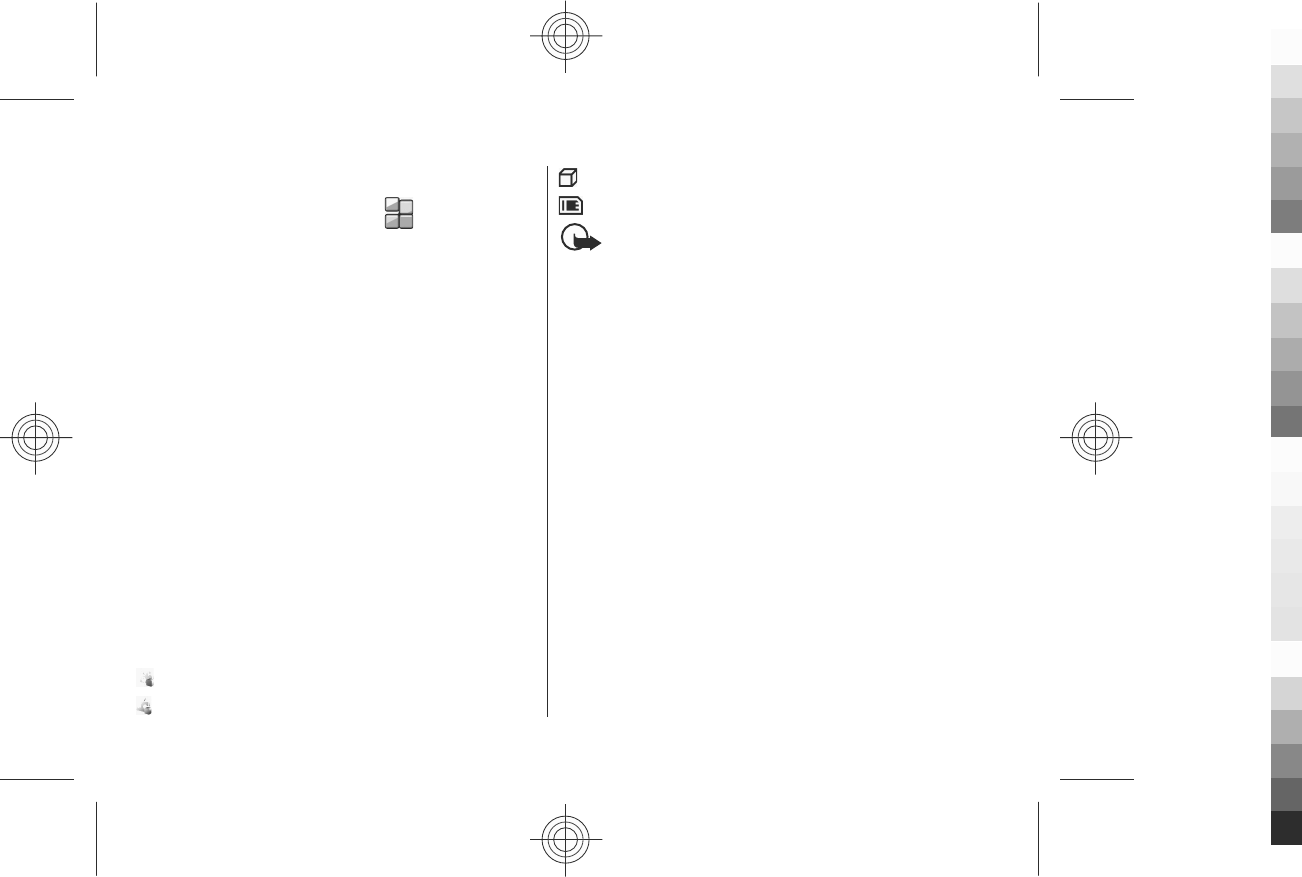
11. Downloads
You can download and install applications to your device.
Application manager
With Application manager, you can see the software
packages installed in your device. You can view details of
installed applications, remove applications, and define
installation settings.
You can install two types of applications and software to
your device:
●JME applications based on Java™ technology with
the .jad or .jar file extensions
●Other applications and software suitable for the
Symbian operating system with the .sis or .sisx file
extensions
Only install software that is compatible with your device.
Install applications and software
You can transfer installation files to your device from a
compatible computer, download them during browsing,
or receive them in a multimedia message, as an e-mail
attachment, or using other connectivity methods, such as
Bluetooth connectivity. You can use Nokia Application
Installer in Nokia PC Suite to install an application to your
device.
Icons in Application manager indicate the following:
.sis or .sisx application
Java application
application not fully installed
application installed in the memory card
Important: Only install and use applications and
other software from trusted sources, such as applications
that are Symbian Signed or have passed the Java Verified
testing.
Before installation, note the following:
●To view the application type, version number, and the
supplier or manufacturer of the application, select
Options > View details.
To display the security certificate details of the
application, select Details: > Certificates: > View
details.
●If you install a file that contains an update or repair to
an existing application, you can only restore the
original application if you have the original installation
file or a full backup copy of the removed software
package. To restore the original application, remove
the application, and install the application again from
the original installation file or the backup copy.
The .jar file is required for installing Java applications.
If it is missing, the device may ask you to download it.
If there is no access point defined for the application,
you are asked to select one. When you are downloading
the .jar file, you may need to enter a user name and
password to access the server. You obtain these from
the supplier or manufacturer of the application.
47
Downloads
Cyan
Cyan
Magenta
Magenta
Yellow
Yellow
Black
Black
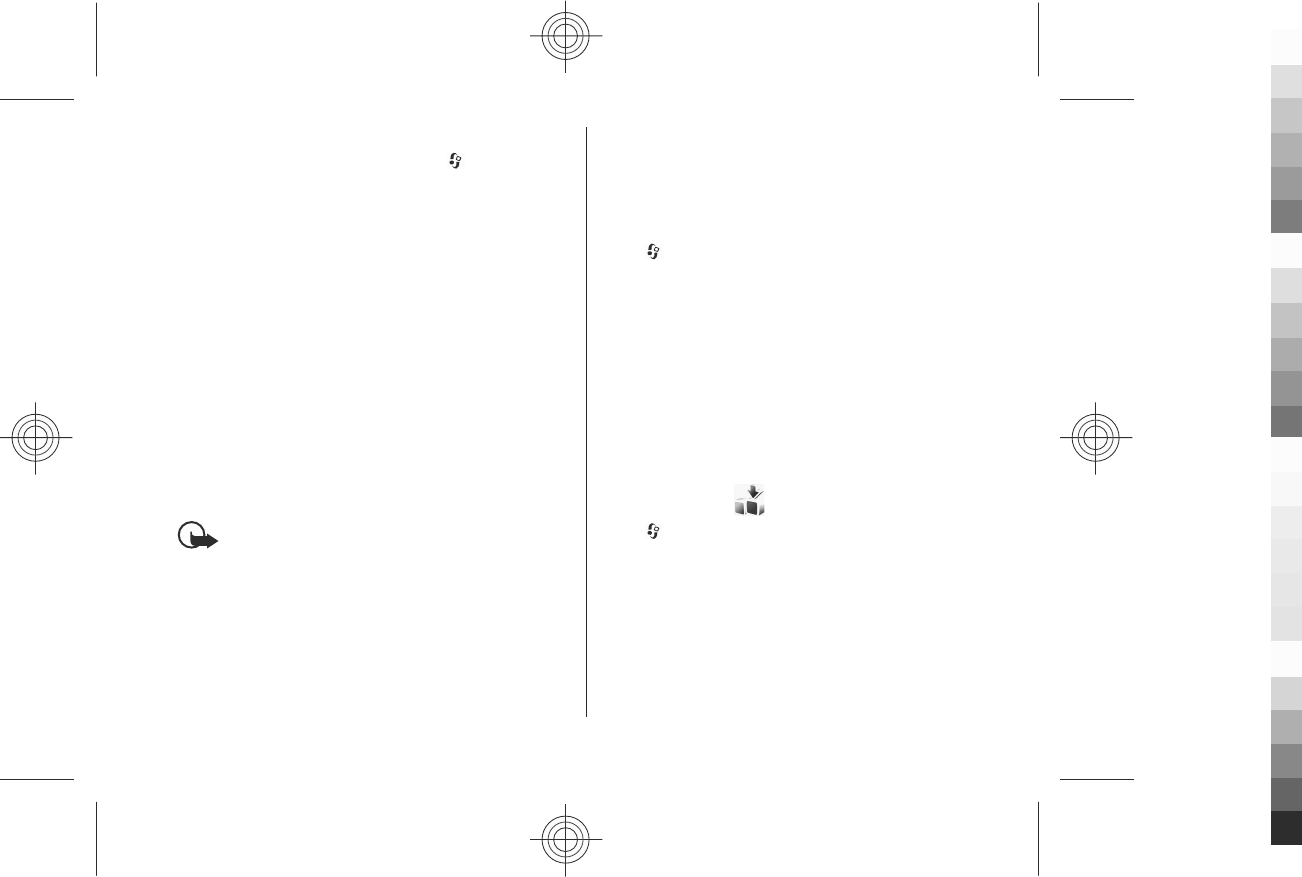
To install an application or software, do the following:
1. To locate an installation file, select >
Installations > App. mgr.. Alternatively, search
installation files using File manager, or select
Messaging > Inbox, and open a message that
contains an installation file.
2. In Application manager, select Options > Install. In
other applications, select the installation file to start
the installation.
During installation, the device shows information
about the progress of the installation. If you install an
application without a digital signature or certification,
the device displays a warning. Continue installation
only if you are sure of the origin and contents of the
application.
To start an installed application, select the application. If
the application does not have a default folder defined, it
is installed in the Installations folder in the main menu.
To see which software packages are installed or removed
and when, select Options > View log.
Important: Your device can only support one
antivirus application. Having more than one application
with antivirus functionality could affect performance and
operation or cause the device to stop functioning.
After you install applications to a compatible memory
card, installation files (.sis, .sisx) remain in the device
memory. The files may use large amounts of memory and
prevent you from storing other files. To maintain sufficient
memory, use Nokia PC Suite to back up installation files to
a compatible PC, then use the file manager to remove the
installation files from the device memory. If the .sis file is
a message attachment, delete the message from the
Messaging inbox.
Remove applications and software
Select > Applications > App. mgr..
Scroll to a software package, and select Options >
Uninstall. Select Yes to confirm.
If you remove software, you can only reinstall it if you have
the original software package or a full backup of the
removed software package. If you remove a software
package, you may no longer be able to open documents
created with that software.
If another software package depends on the software
package that you removed, the other software package
may stop working. For more information, see the
documentation of the installed software package.
Download!
Select > Download!.
With Download! (network service), you can browse,
download, and install items, such as latest applications
and related documents, to your device from the web.
The items are categorised under catalogues and folders
provided by Nokia or independent service providers. Some
items may be chargeable, but you can usually preview
them free of charge.
Download! uses available network connections to access
the most up-to-date content. For information on
48
Downloads
Cyan
Cyan
Magenta
Magenta
Yellow
Yellow
Black
Black

additional items available through Download!, contact
your service provider, or the supplier or manufacturer of
the item.
Manage items
Select > Download!.
To open an item or view the content of a folder or
catalogue, select the item, folder, or catalogue.
To buy the selected item, select Options > Buy.
To download an item that is free of charge, select
Options > Get.
To search for an item, select Options > Search.
To adjust the settings, select Options > Applications >
Settings.
To view a list of downloaded items, select Options > My
items.
49
Downloads
Cyan
Cyan
Magenta
Magenta
Yellow
Yellow
Black
Black
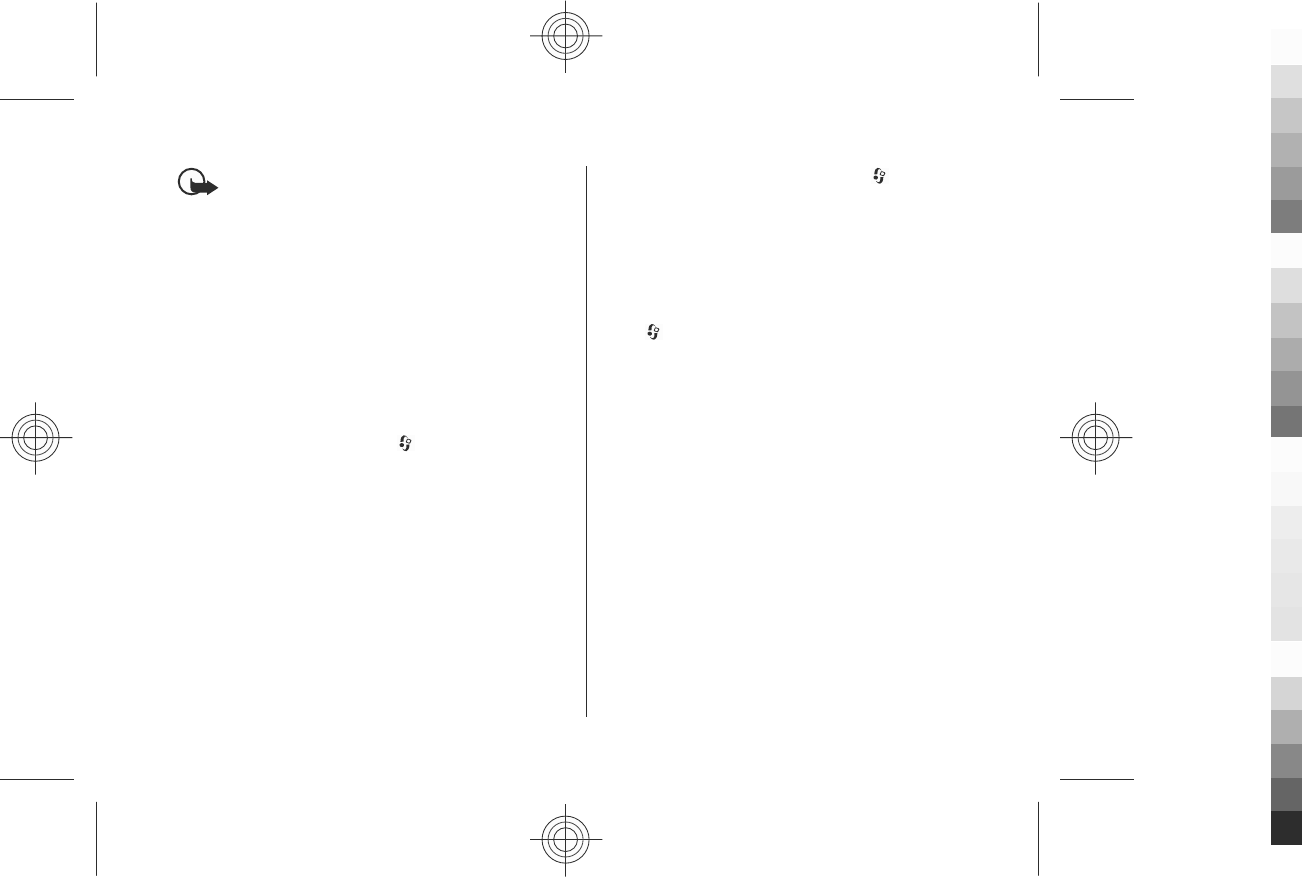
12. Protect your device and data
Important: Your device can only support one
antivirus application. Having more than one application
with antivirus functionality could affect performance and
operation or cause the device to stop functioning.
Lock the device
The lock code protects your device against unauthorised
use. The preset code is 12345.
To lock the device, in the active standby, press the power
key, and select Lock phone.
To unlock your device, select Unlock, enter the lock code,
and select OK.
To change the lock code, select > Tools > Settings
and General > Security > Phone and SIM card. Enter
the old code and then the new code twice. The new code
can be 4-255 characters long. Both alphabets and digits
can be used, and both uppercase and lowercase alphabets
are possible.
Write down the new code, and keep it secret and in a safe
place separate from your device. If you forget the lock code
and your device is locked, you must take the device to a
Nokia authorised service facility and additional charges
may apply. To unlock the device, the software must be
reloaded, and the data you have saved in the device may
be lost.
You can also lock the device remotely by sending a text
message to the device. To enable remote locking, and to
define the text for the message, select > Tools >
Settings and General > Security > Phone and SIM
card > Remote phone locking > Enabled. Enter the
remote lock message, and confirm the message. The
message must be at least 5 characters long. Write down
the text, as you may need it later.
Memory card security
Select > Office > File mgr..
You can protect a memory card with a password to prevent
unauthorised access. To set a password, select Options >
Memory card password > Set. The password can be up
to 8 characters long and is case-sensitive. The password is
stored in your device. You do not need to enter it again
while you use the memory card on the same device. If you
use the memory card on another device, you are asked for
the password. Not all memory cards support password
protection.
To remove the memory card password, select Options >
Memory card password > Remove. When you remove
the password, the data on the memory card is not
protected against unauthorised use.
To open a locked memory card, select Options > Unlock
memory card. Enter the password.
If you cannot recall the password to unlock a locked
memory card, you may reformat the card, in which case
the card is unlocked and password removed. Formatting
a memory card deletes all data stored on the card.
50
Protect your device and data
Cyan
Cyan
Magenta
Magenta
Yellow
Yellow
Black
Black
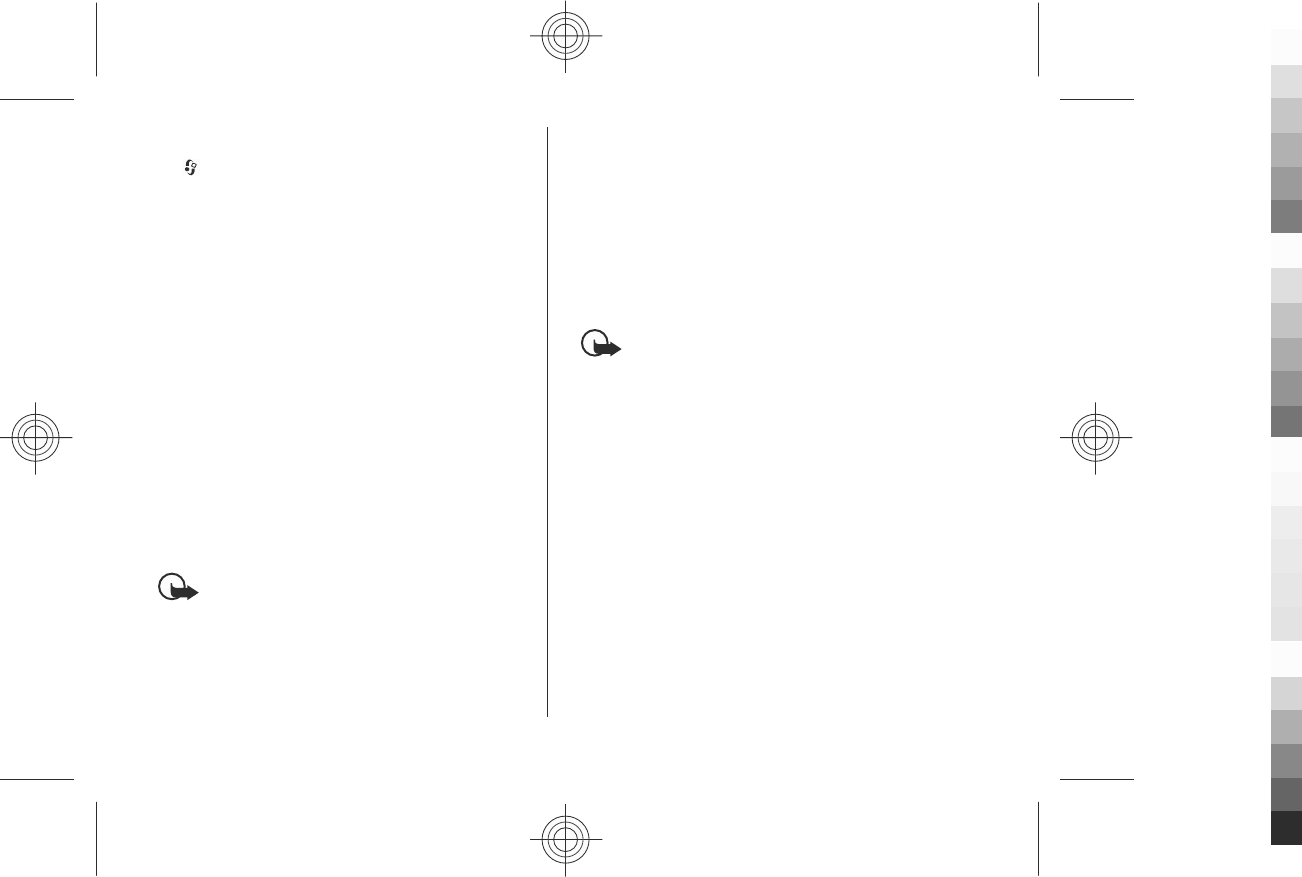
Back up data
Select > Office > File mgr..
It is recommended that you back up the device memory
regularly to a memory card or a compatible computer.
To back up information from the device memory to a
memory card, select Options > Back up phone
memory.
To restore information from the memory card to the
device memory, select Options > Restore from mem.
card.
You can also connect your device to a compatible
computer and use Nokia PC Suite to back up data.
Be careful when you connect
Your device supports several connectivity methods and,
like computers, may be exposed to viruses and other
harmful content. Exercise caution with messages,
connectivity requests, browsing, and downloads.
Messages
●If you receive suspicious messages, do not open the
attachments.
Important: Exercise caution when opening
messages. Messages may contain malicious software or
otherwise be harmful to your device or PC.
Bluetooth
●When you are not using Bluetooth connectivity, select
Bluetooth > Off or My phone's visibility >
Hidden.
●Do not pair with unknown devices or devices that you
do not trust.
Browsing and downloads
●If you have tried to access or have accessed confidential
information requiring passwords, empty the cache
after each use. The information or services you have
accessed are stored in the cache.
Important: Use only services that you trust and
that offer adequate security and protection against
harmful software.
51
Protect your device and data
Cyan
Cyan
Magenta
Magenta
Yellow
Yellow
Black
Black

13. Settings
Select > Tools > Settings.
You can define and modify various settings of your device.
Modifying these settings affects the operation of your
device across several applications.
Some settings may be preset for the device or sent to you
in a special message by your service provider. You may not
be able to change such settings.
Select the setting you want to edit, and modify the values
in the following ways:
●Switch between two values, such as on or off.
●Select a value from a list.
●Open a text editor to enter a value.
●Scroll left or right to adjust a value.
General settings
Select > Tools > Settings and General.
Select from the following:
●Personalisation — Change the display settings, and
personalise the device.
●Date and time — Change the date and time.
●Enhancement — Define the settings for your
accessories.
●Slide handling — Change the slide settings.
●My own key — Change the function that is activated
when you press the internet or messaging key.
●Sensor settings — Change the sensor settings.
●Security — Define the security settings.
●Factory settings — Restore the original settings of the
device.
●Positioning — Define the positioning method and
server for GPS-based applications.
Phone settings
Select > Tools > Settings and Phone.
Select from the following:
●Call — Define general call settings.
●Call divert — Define call divert settings.
●Call barring — Define call barring settings.
●Network — Define the network settings.
Connection settings
Select > Tools > Settings and Connection.
Select from the following:
●Bluetooth — Edit the Bluetooth settings.
●USB — Edit the data cable settings.
●Destinations — Define new or edit existing access
points. Some or all access points may be preset for your
device by your service provider, and you may not be
able to create, edit, or remove them.
●Packet data — Define when packet data network is
attached, and enter the default packet switched access
point name if you use your device as a modem for a
computer.
52
Settings
Cyan
Cyan
Magenta
Magenta
Yellow
Yellow
Black
Black

●Data call — Set the length of the time-out period after
which data call connections automatically end.
●Video sharing — Enable video sharing, select the SIP
profile for video sharing, and define the video saving
settings.
●Presence — Edit the settings for presence (network
service). To register for the service, contact your service
provider.
●SIP settings — View or create session initiation
protocol (SIP) profiles.
●XDM settings — Create an XDM profile. The XDM profile
is required for many communications applications, for
example, presence.
●Remote drives — Connect the device to a remote
drive.
●Configurations — View and delete trusted servers
from which your device may receive configuration
settings.
●APN control — Restrict packet data connections.
Application settings
Select > Tools > Settings and Applications.
Select an application from the list to adjust its settings.
53
Settings
Cyan
Cyan
Magenta
Magenta
Yellow
Yellow
Black
Black
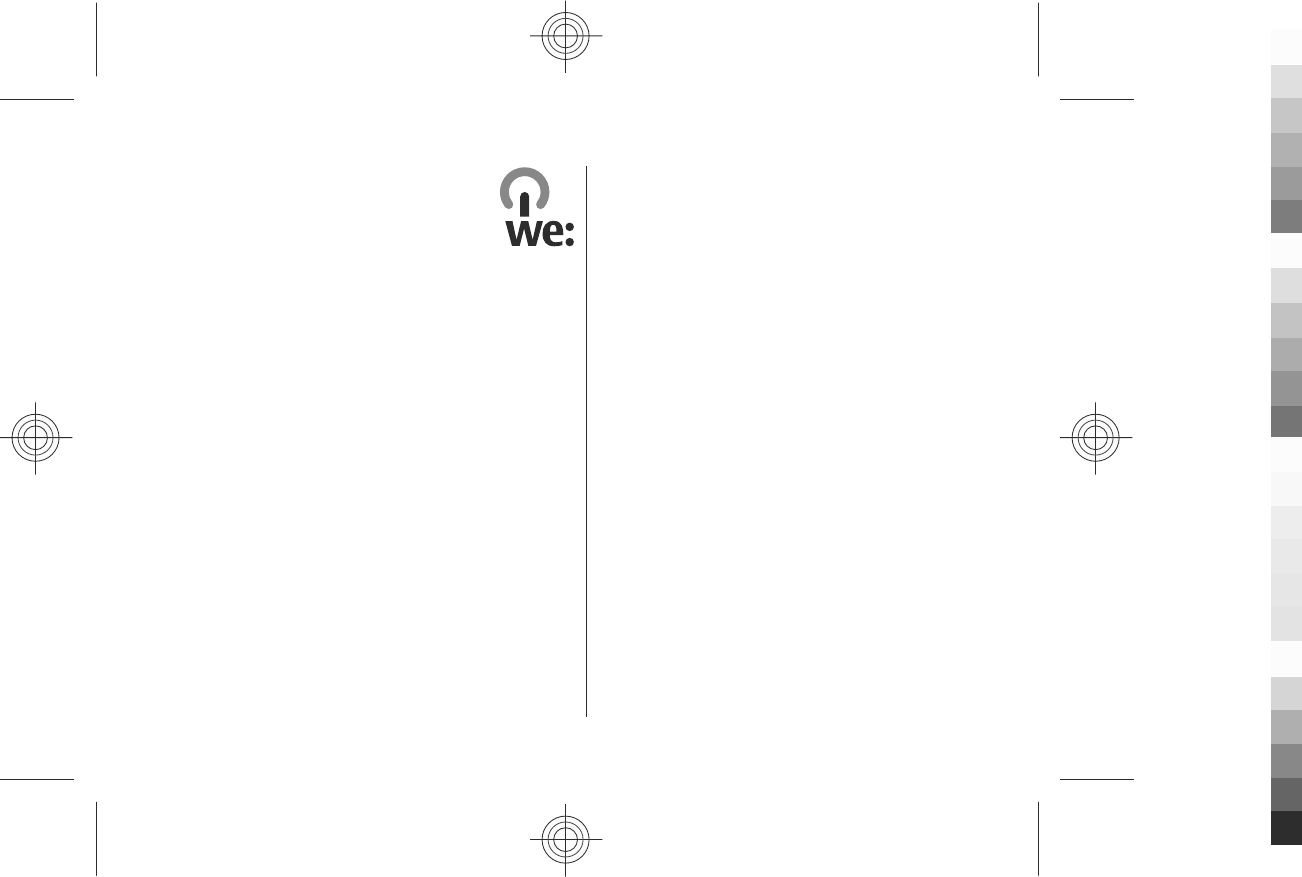
14. Green tips
Here are tips on how you can contribute to
protecting the environment.
Save energy
When you have fully charged the battery and disconnected
the charger from the device, unplug the charger from the
wall outlet.
You do not need to charge your battery so often if you do
the following:
●Close and disable applications, services, and
connections when not in use.
●Decrease the brightness of the screen.
●Set the device to enter the power saver mode after the
minimum period of inactivity, if available in your
device.
●Disable unnecessary sounds, such as keypad and
ringing tones.
Recycle
Most of the materials in a Nokia phone are recyclable.
Check how to recycle your Nokia products at
www.nokia.com/werecycle, or with a mobile device,
www.nokia.mobi/werecycle.
Recycle packaging and user guides at your local recycling
scheme.
Save paper
This user guide helps you get started with your device. For
more detailed instructions, open the in-device help (in
most applications, select Options > Help). For further
support, see www.nokia.com/support.
Learn more
For more information on the environmental attributes of
your device, see www.nokia.com/ecodeclaration.
54
Green tips
Cyan
Cyan
Magenta
Magenta
Yellow
Yellow
Black
Black

Accessories
Warning: Use only batteries, chargers, and
accessories approved by Nokia for use with this particular
model. The use of any other types may invalidate any
approval or warranty, and may be dangerous. In
particular, use of unapproved chargers or batteries may
present a risk of fire, explosion, leakage, or other hazard.
For availability of approved accessories, please check with
your dealer. When you disconnect the power cord of any
accessory, grasp and pull the plug, not the cord.
55
Accessories
Cyan
Cyan
Magenta
Magenta
Yellow
Yellow
Black
Black

Battery
Battery and charger information
Your device is powered by a rechargeable battery. The
battery intended for use with this device is BP-4L. Nokia
may make additional battery models available for this
device. This device is intended for use when supplied with
power from the following chargers: AC-8. The exact
charger model number may vary depending on the type
of plug. The plug variant is identified by one of the
following: E, EB, X, AR, U, A, C, K, or UB.
The battery can be charged and discharged hundreds of
times, but it will eventually wear out. When the talk and
standby times are noticeably shorter than normal, replace
the battery. Use only Nokia approved batteries, and
recharge your battery only with Nokia approved chargers
designated for this device.
If a battery is being used for the first time or if the battery
has not been used for a prolonged period, it may be
necessary to connect the charger, then disconnect and
reconnect it to begin charging the battery. If the battery
is completely discharged, it may take several minutes
before the charging indicator appears on the display or
before any calls can be made.
Safe removal. Always switch the device off and disconnect
the charger before removing the battery.
Proper charging. Unplug the charger from the electrical
plug and the device when not in use. Do not leave a fully
charged battery connected to a charger, since
overcharging may shorten its lifetime. If left unused, a fully
charged battery will lose its charge over time.
Avoid extreme temperatures. Always try to keep the
battery between 15°C and 25°C (59°F and 77°F). Extreme
temperatures reduce the capacity and lifetime of the
battery. A device with a hot or cold battery may not work
temporarily. Battery performance is particularly limited in
temperatures well below freezing.
Do not short-circuit. Accidental short-circuiting can occur
when a metallic object such as a coin, clip, or pen causes
direct connection of the positive (+) and negative (-)
terminals of the battery. (These look like metal strips on
the battery.) This might happen, for example, when you
carry a spare battery in your pocket or purse. Short-
circuiting the terminals may damage the battery or the
connecting object.
Disposal. Do not dispose of batteries in a fire as they may
explode. Dispose of batteries according to local
regulations. Please recycle when possible. Do not dispose
as household waste.
Leak. Do not dismantle, cut, open, crush, bend, puncture,
or shred cells or batteries. In the event of a battery leak,
prevent battery liquid contact with skin or eyes. If this
happens, flush the affected areas immediately with water,
or seek medical help.
Damage. Do not modify, remanufacture, attempt to insert
foreign objects into the battery, or immerse or expose it
to water or other liquids. Batteries may explode if
damaged.
Correct use. Use the battery only for its intended purpose.
Improper battery use may result in a fire, explosion, or
56
Battery
Cyan
Cyan
Magenta
Magenta
Yellow
Yellow
Black
Black
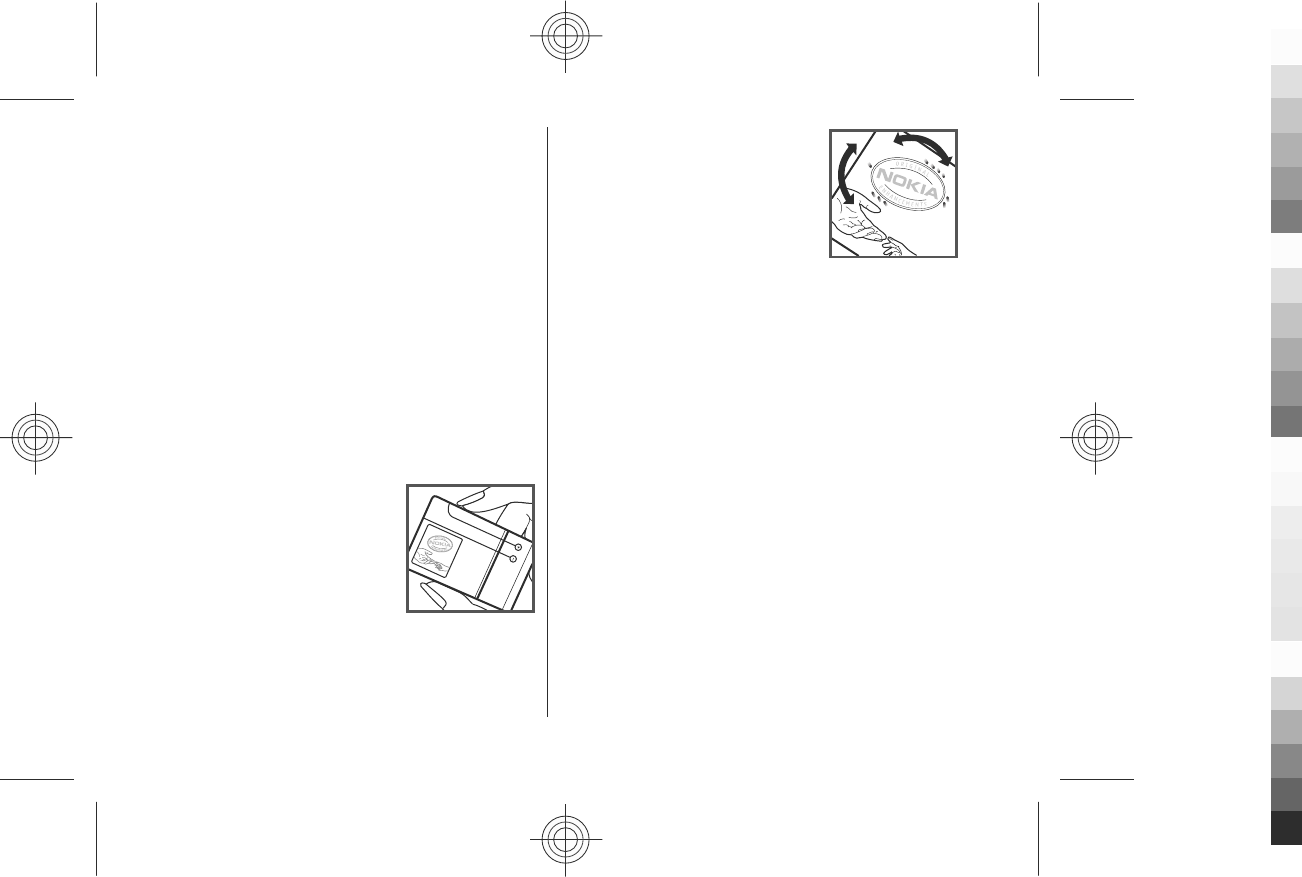
other hazard. If the device or battery is dropped, especially
on a hard surface, and you believe the battery has been
damaged, take it to a service centre for inspection before
continuing to use it. Never use any charger or battery that
is damaged. Keep your battery out of the reach of small
children.
Safe removal. Always switch the device off and disconnect
the charger before removing the battery.
Nokia battery authentication
guidelines
Always use original Nokia batteries for your safety. To
check that you are getting an original Nokia battery,
purchase it from a Nokia authorised service centre or
dealer, and inspect the hologram label using the following
steps:
Authenticate hologram
1. When you look at the hologram on
the label, you should see the Nokia
connecting hands symbol from
one angle and the Nokia Original
Enhancements logo when looking
from another angle.
2. When you angle the hologram left,
right, down and up, you should see
1, 2, 3 and 4 dots on each side
respectively.
Successful completion of the steps is
not a total assurance of the
authenticity of the battery. If you
cannot confirm authenticity or if you
have any reason to believe that your
Nokia battery with the hologram on the label is not an
authentic Nokia battery, you should refrain from using it,
and take it to the nearest Nokia authorised service centre
or dealer for assistance.
To find out more about original Nokia batteries, see
www.nokia.com/battery.
57
Battery
Cyan
Cyan
Magenta
Magenta
Yellow
Yellow
Black
Black

Taking care of your device
Your device is a product of superior design and
craftsmanship and should be treated with care. The
following suggestions will help you protect your warranty
coverage.
●Keep the device dry. Precipitation, humidity, and all
types of liquids or moisture can contain minerals that
will corrode electronic circuits. If your device does get
wet, remove the battery, and allow the device to dry
completely before replacing it.
●Do not use or store the device in dusty, dirty areas. Its
moving parts and electronic components can be
damaged.
●Do not store the device in high or cold temperature.
High temperatures can shorten the life of electronic
devices, damage batteries, and warp or melt certain
plastics. When the device warms to its normal
temperature from a cold temperature, moisture can
form inside the device and damage electronic circuit
boards.
●Do not attempt to open the device other than as
instructed in this guide.
●Do not drop, knock, or shake the device. Rough
handling can break internal circuit boards and fine
mechanics.
●Do not use harsh chemicals, cleaning solvents, or strong
detergents to clean the device. Only use a soft, clean,
dry cloth to clean the surface of the device.
●Do not paint the device. Paint can clog the moving parts
and prevent proper operation.
●Use only the supplied or an approved replacement
antenna. Unauthorised antennas, modifications, or
attachments could damage the device and may violate
regulations governing radio devices.
●Use chargers indoors.
●Backup all data you want to keep, such as contacts and
calendar notes.
●To reset the device from time to time for optimum
performance, power off the device and remove the
battery.
These suggestions apply equally to your device, battery,
charger, or any accessory.
Recycle
Always return your used electronic products, batteries,
and packaging materials to dedicated collection points.
This way you help prevent uncontrolled waste disposal
and promote the recycling of materials. Check product
environmental information and how to recycle your Nokia
products at www.nokia.com/werecycle, or nokia.mobi/
werecycle.
The crossed-out wheeled-bin symbol on your
product, battery, literature, or packaging reminds
you that all electrical and electronic products,
batteries, and accumulators must be taken to
separate collection at the end of their working life. This
58
Taking care of your device
Cyan
Cyan
Magenta
Magenta
Yellow
Yellow
Black
Black

requirement applies in the European Union. Do not
dispose of these products as unsorted municipal waste.
For more environmental information, see the product Eco-
Declarations at www.nokia.com/environment.
59
Taking care of your device
Cyan
Cyan
Magenta
Magenta
Yellow
Yellow
Black
Black

Additional safety information
Small children
Your device and its accessories are not toys. They may
contain small parts. Keep them out of the reach of small
children.
Operating environment
This device meets RF exposure guidelines in the normal
use position at the ear or at least 2.2 centimetre (7/8
inch)away from the body. Any carry case, belt clip, or
holder for body-worn operation should not contain metal
and should position the device the above-stated distance
from your body.
To send data files or messages requires a quality
connection to the network. Data files or messages may be
delayed until such a connection is available. Follow the
separation distance instructions until the transmission is
completed.
Medical devices
Operation of any radio transmitting equipment, including
wireless phones, may interfere with the functionality of
inadequately protected medical devices. Consult a
physician or the manufacturer of the medical device to
determine if they are adequately shielded from external
RF energy or if you have any questions. Switch off your
device in health care facilities when any regulations
posted in these areas instruct you to do so. Hospitals or
health care facilities may be using equipment that could
be sensitive to external RF energy.
Implanted medical devices
Manufacturers of medical devices recommend that a
minimum separation of 15.3 centimetres (6 inches) should
be maintained between a wireless device and an
implanted medical device, such as a pacemaker or
implanted cardioverter defibrillator, to avoid potential
interference with the medical device. Persons who have
such devices should:
●Always keep the wireless device more than 15.3
centimetres (6 inches) from the medical device when
the wireless device is turned on.
●Not carry the wireless device in a breast pocket.
●Hold the wireless device to the ear opposite the medical
device to minimise the potential for interference.
●Turn the wireless device off immediately if there is any
reason to suspect that interference is taking place.
●Read and follow the directions from the manufacturer
of their implanted medical device.
If you have any questions about using your wireless device
with an implanted medical device, consult your health
care provider.
60
Additional safety information
Cyan
Cyan
Magenta
Magenta
Yellow
Yellow
Black
Black
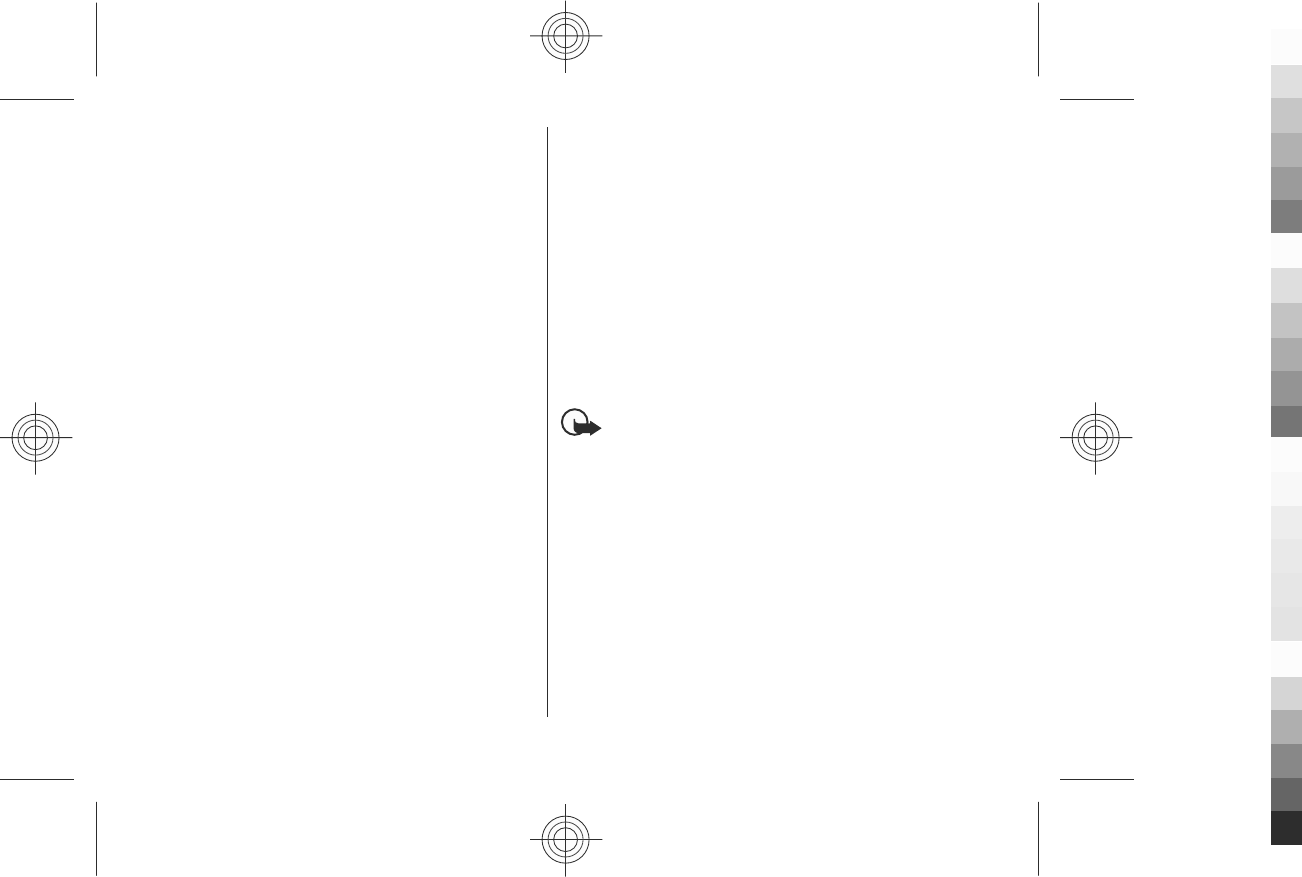
Hearing aids
Some digital wireless devices may interfere with some
hearing aids. If interference occurs, consult your service
provider.
Vehicles
RF signals may affect improperly installed or inadequately
shielded electronic systems in motor vehicles such as
electronic fuel injection, electronic antilock braking,
electronic speed control, and air bag systems. For more
information, check with the manufacturer of your vehicle
or its equipment.
Only qualified personnel should service the device or
install the device in a vehicle. Faulty installation or service
may be dangerous and may invalidate your warranty.
Check regularly that all wireless device equipment in your
vehicle is mounted and operating properly. Do not store
or carry flammable liquids, gases, or explosive materials
in the same compartment as the device, its parts, or
accessories. Remember that air bags inflate with great
force. Do not place your device or accessories in the air bag
deployment area.
Switch off your device before boarding an aircraft. The use
of wireless teledevices in an aircraft may be dangerous to
the operation of the aircraft and may be illegal.
Potentially explosive environments
Switch off your device in any area with a potentially
explosive atmosphere. Obey all posted instructions. Sparks
in such areas could cause an explosion or fire resulting in
bodily injury or death. Switch off the device at refuelling
points such as near gas pumps at service stations. Observe
restrictions in fuel depots, storage, and distribution areas;
chemical plants; or where blasting operations are in
progress. Areas with a potentially explosive atmosphere
are often, but not always, clearly marked. They include
areas where you would be advised to turn off your vehicle
engine, below deck on boats, chemical transfer or storage
facilities and where the air contains chemicals or particles
such as grain, dust, or metal powders. You should check
with the manufacturers of vehicles using liquefied
petroleum gas (such as propane or butane) to determine
if this device can be safely used in their vicinity.
Emergency calls
Important: This device operates using radio
signals, wireless networks, landline networks, and user-
programmed functions. If your device supports voice calls
over the internet (internet calls), activate both the internet
calls and the cellular phone. The device may attempt to
make emergency calls over both the cellular networks and
through your internet call provider if both are activated.
Connections in all conditions cannot be guaranteed. You
should never rely solely on any wireless device for
essential communications like medical emergencies.
To make an emergency call:
1. If the device is not on, switch it on. Check for adequate
signal strength. Depending on your device, you may
also need to complete the following:
●Insert a SIM card if your device uses one.
61
Additional safety information
Cyan
Cyan
Magenta
Magenta
Yellow
Yellow
Black
Black

●Remove certain call restrictions you have activated
in your device.
●Change your profile from Offline or Flight profile to
an active profile.
2. Press the end key as many times as needed to clear the
display and ready the device for calls.
3. Enter the official emergency number for your present
location. Emergency numbers vary by location.
4. Press the call key.
When making an emergency call, give all the necessary
information as accurately as possible. Your wireless device
may be the only means of communication at the scene of
an accident. Do not end the call until given permission to
do so.
Certification information (SAR)
This mobile device meets guidelines for exposure to
radio waves.
Your mobile device is a radio transmitter and receiver. It
is designed not to exceed the limits for exposure to radio
waves recommended by international guidelines. These
guidelines were developed by the independent scientific
organisation ICNIRP and include safety margins designed
to assure the protection of all persons, regardless of age
and health.
The exposure guidelines for mobile devices employ a unit
of measurement known as the Specific Absorption Rate or
SAR. The SAR limit stated in the ICNIRP guidelines is 2.0
watts/kilogram (W/kg) averaged over 10 grams of tissue.
Tests for SAR are conducted using standard operating
positions with the device transmitting at its highest
certified power level in all tested frequency bands. The
actual SAR level of an operating device can be below the
maximum value because the device is des igned to use only
the power required to reach the network. That amount
changes depending on a number of factors such as how
close you are to a network base station.
The highest SAR value under the ICNIRP guidelines for use
of the device at the ear is 0.85 W/kg.
Use of device accessories may result in different SAR
values. SAR values may vary depending on national
reporting and testing requirements and the network
band. Additional SAR information may be provided under
product information at www.nokia.com.
Your mobile device is also designed to meet the
requirements for exposure to radio waves established by
the Federal Communications Commission (USA) and
Industry Canada. These requirements set a SAR limit of 1.6
W/kg averaged over one gram of tissue. The highest SAR
value reported under this standard during product
certification for use at the ear is 0.93 W/kg and when
properly worn on the body is 0.37 W/kg.
62
Additional safety information
Cyan
Cyan
Magenta
Magenta
Yellow
Yellow
Black
Black

Index
A
access codes 10
alarm
calendar note 39
alarm clock 23
animated screen saver 25
anniversary notes 39
antennas 24
application manager 47
application settings 53
applications 22, 47
assisted GPS (A-GPS) 29
audio messages 21
auto-update for time/date 23
B
background image 25
backing up data 51
battery
charging 13
inserting 12
birthday notes 39
blogs 34
Bluetooth
authorising devices 37
pairing 37
passcode 37
receiving data 36
sending data 36
browser 33
cache memory 34
security 35
C
cache memory 34
calculator 45
calls
answering 19
making 19
voice mail 19
camera
capturing images 41
toolbar 41
video clips 41
chat services (IM) 27
Clock
settings 24
connection methods
Bluetooth 36
contacts
creating groups 40
editing 39
images in 40
ringing tones 40
saving 39
converting
measurements 45
D
data connections 38
date and time 23
display
changing the look 25
Download!
managing items 49
E
e-mail 27
F
feeds, news 34
FM radio 43
G
Gallery 41
GPS (global positioning
system) 29
H
headset 14
HSDPA 35
I
IM (instant messaging) 27
indicators 22
installing, applications 47
internet connection 33
63
Index
Cyan
Cyan
Magenta
Magenta
Yellow
Yellow
Black
Black

See also
browser
J
Java applications 47
JME Java application support 47
K
keyboard 20
keypad lock 14
keys 11, 27, 33
L
location information 29
lock code 10, 50
locking
device 50
M
mail for exchange 27
Maps 30
maps
browsing 31
navigating 32
routes 31
measurements
converting 45
media
radio 43
meeting notes 39
meetings
setting up 39
memo notes
See
to-do notes
memory
web cache 34
memory card 15, 16
backing up data 51
locking 50
passwords 50
menus 22
MMS (multimedia message
service) 21
multimedia messages 21
music player
playing 42
transferring music 43
music store 43
N
navigation tools 29
news feeds 34
Nokia Music Store 43
Nokia support information 9
O
Ovi Mail 27
Ovi Share 42
P
pairing
devices 37
passcode 37
PDF reader 46
personalisation 25
phone setup 18
PIN code 10
PIN2 code 10
playing
video and audio 44
positioning information 29
profiles
creating 25
customising 25
selecting ringing tones 25
PUK codes 10
Q
Quickoffice 46
R
radio 43
listening 43
RealPlayer
playing media clips 44
settings 44
remote lock 50
ringing tones
in profiles 25
S
screen saver 25
security
memory card 50
web browser 35
security code 10, 50
64
Index
Cyan
Cyan
Magenta
Magenta
Yellow
Yellow
Black
Black

sending
using Bluetooth 36
settings 10
applications 53
clock 24
RealPlayer 44
settings wizard 18
shortcuts 16
SIM card
inserting 12
SMS (short message service) 21
software applications 47
support resources 9
Switch 18
Switch application 10
switching device on or off 14
Symbian applications 47
T
text entry 20
text messages
sending 21
themes
changing 25
time and date 23
time zone settings 23
to-do notes 39
U
USB data cable 35
V
video clips
playing 44
voice mail
calling 19
changing number 19
volume control 20
W
web connection 33
web logs 34
week settings
calendar alarm 39
world clock 23
Z
Zip manager 46
65
Index
Cyan
Cyan
Magenta
Magenta
Yellow
Yellow
Black
Black
